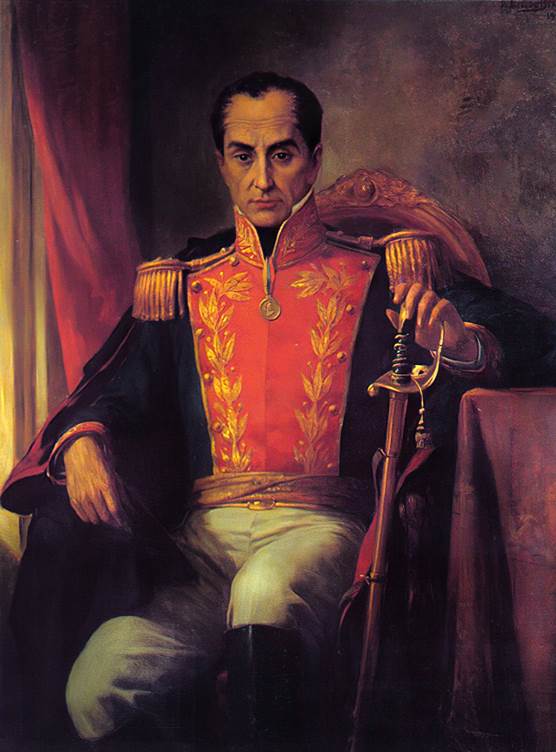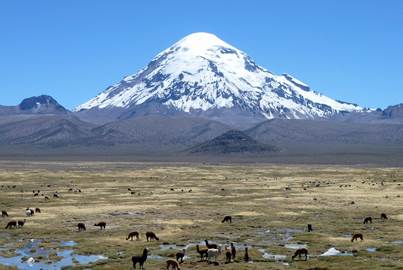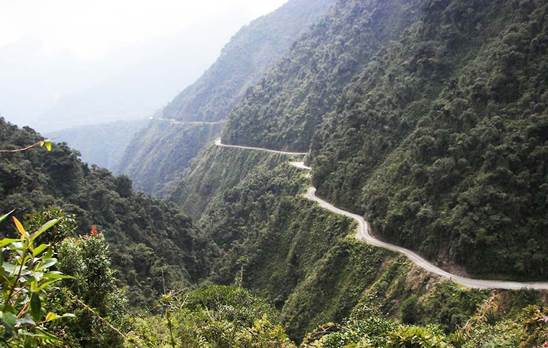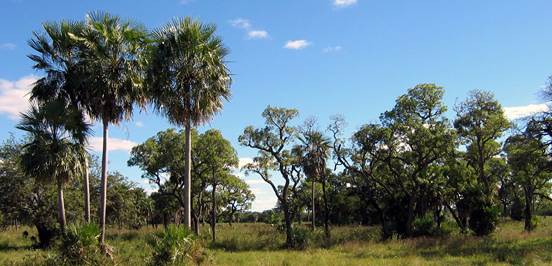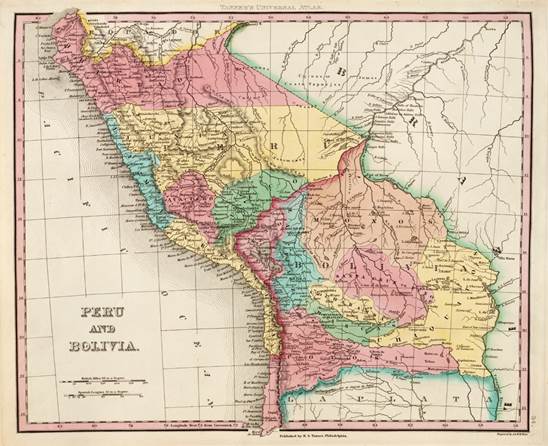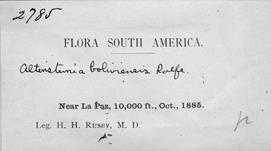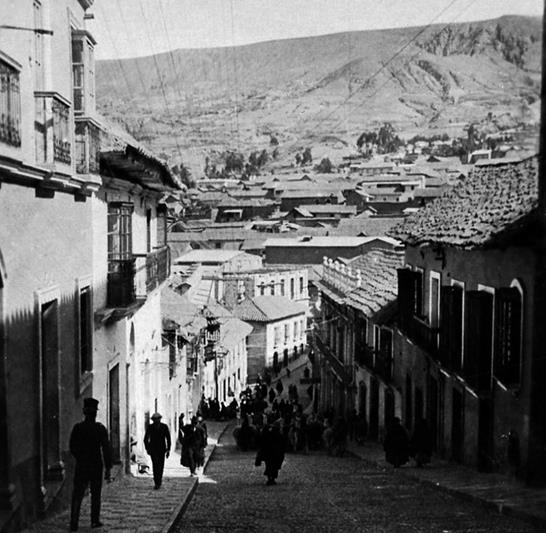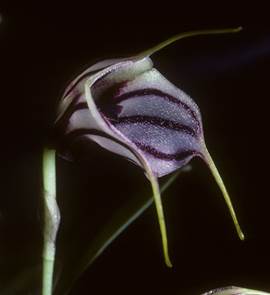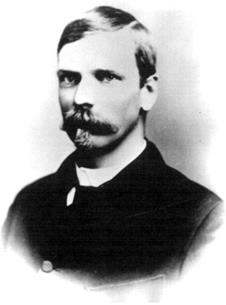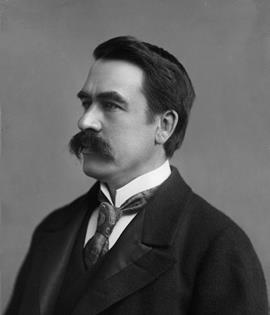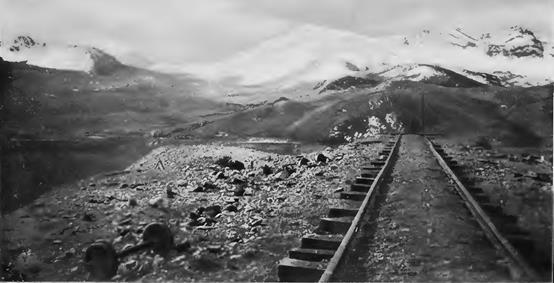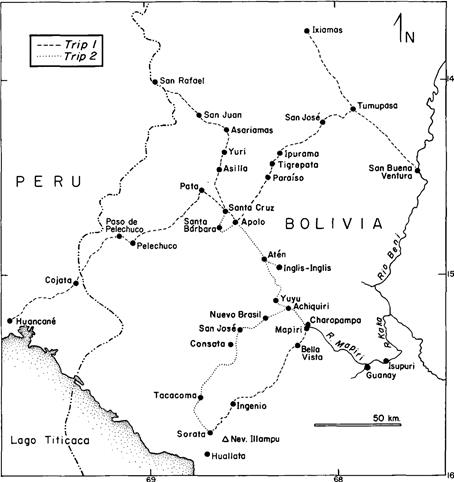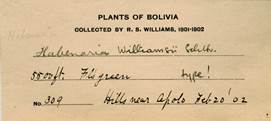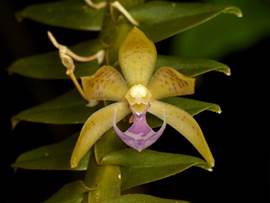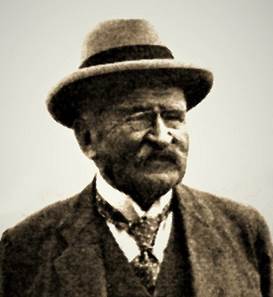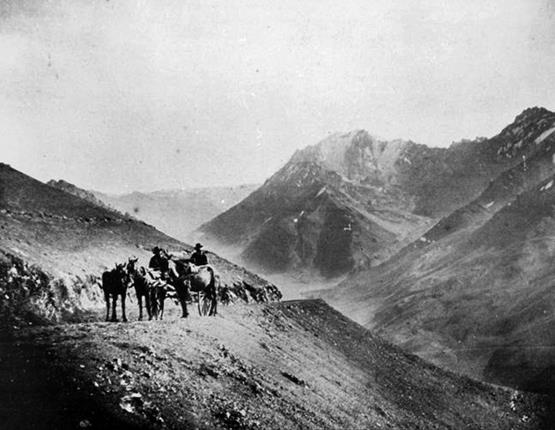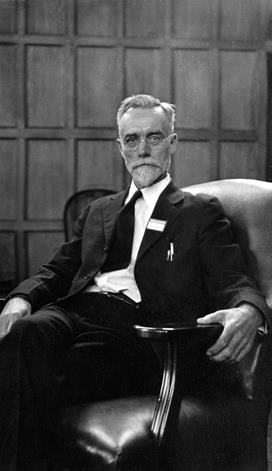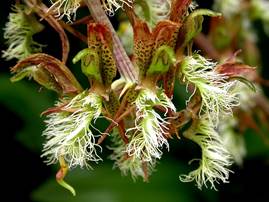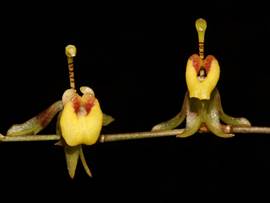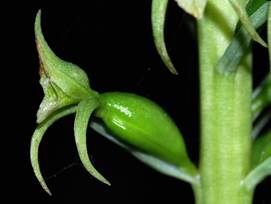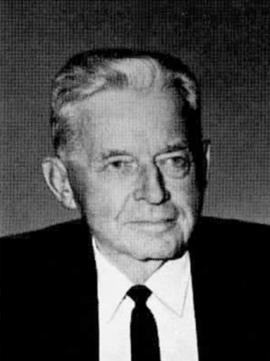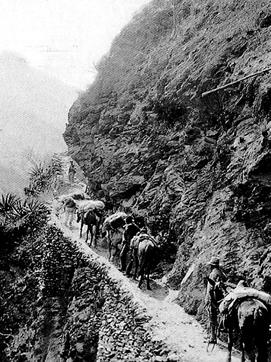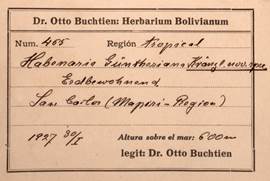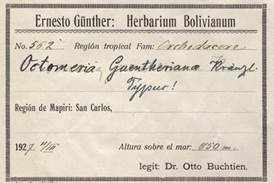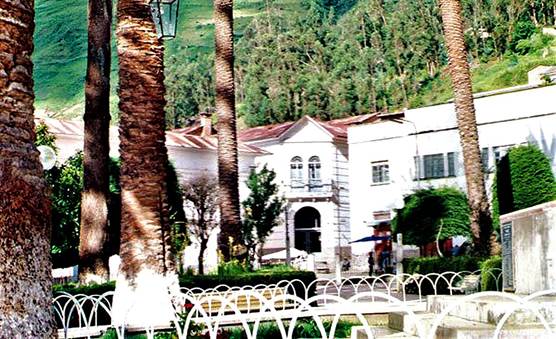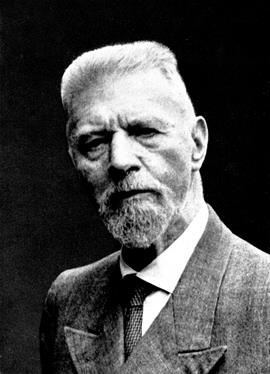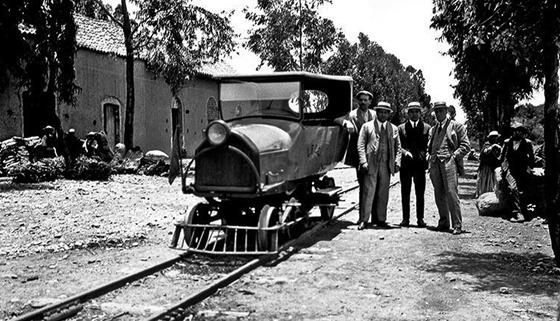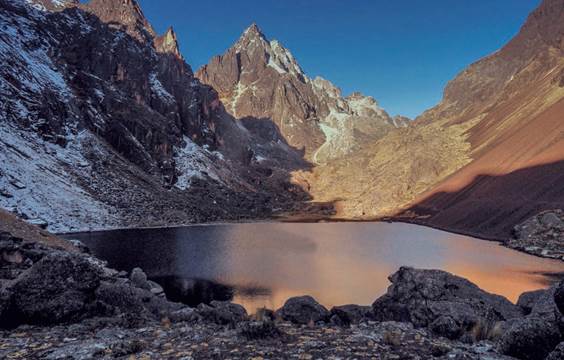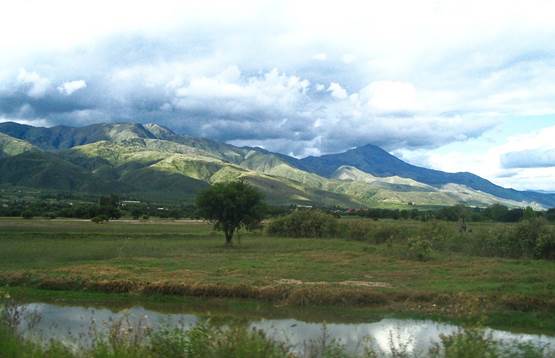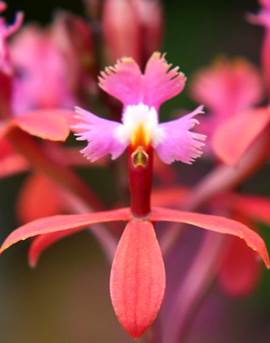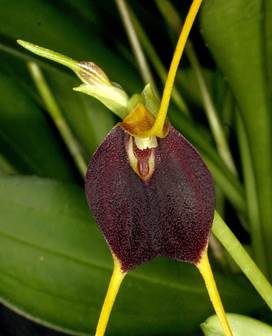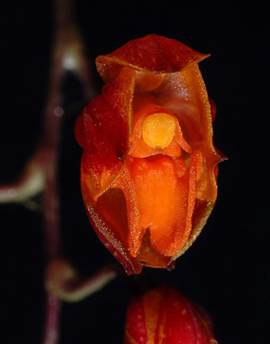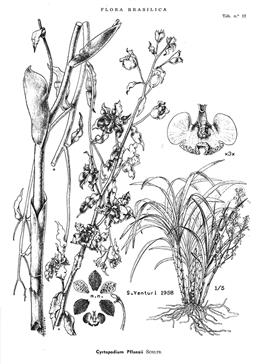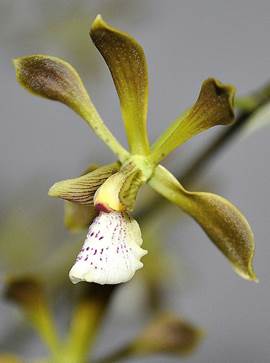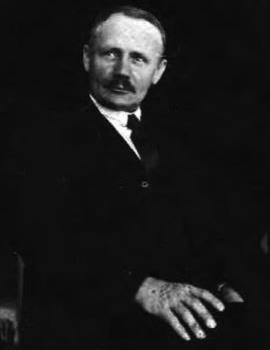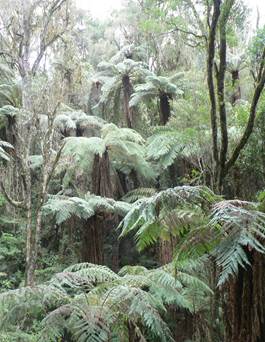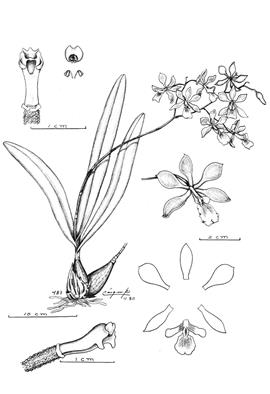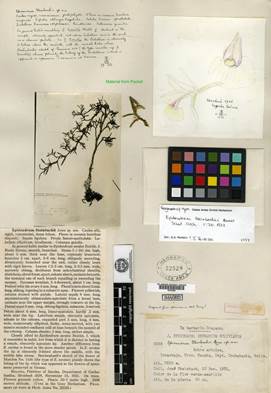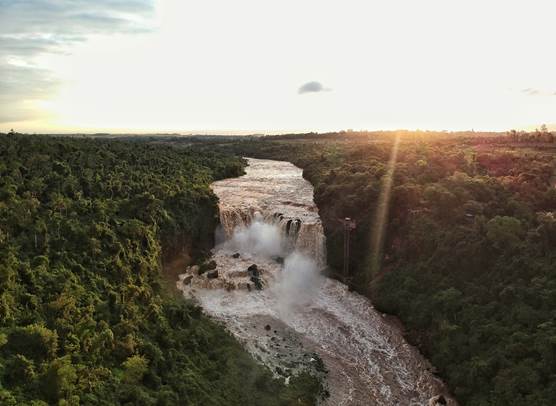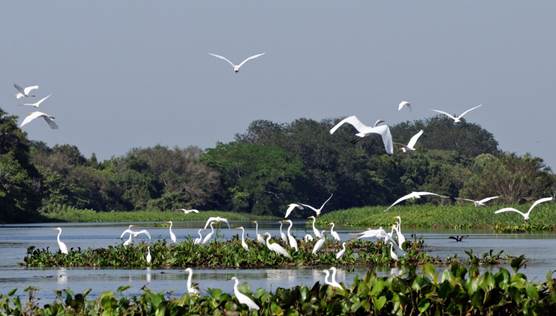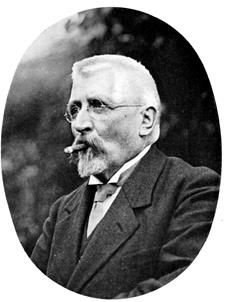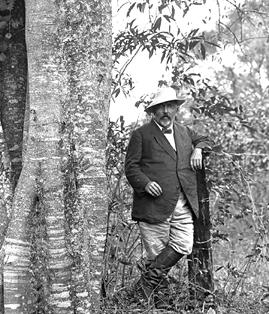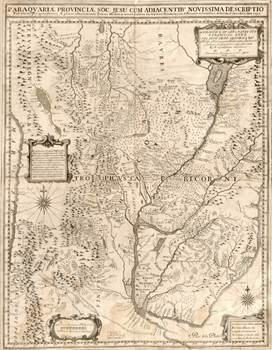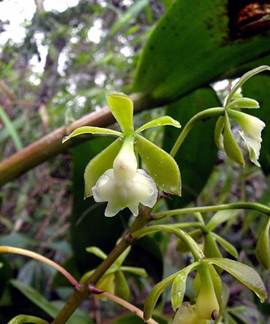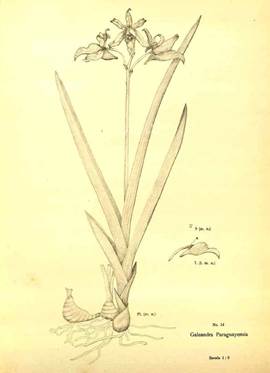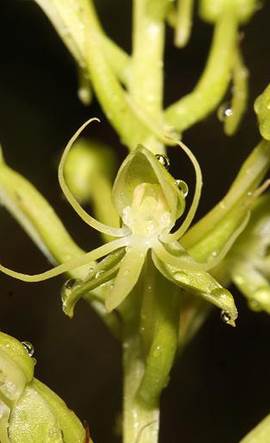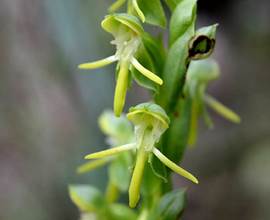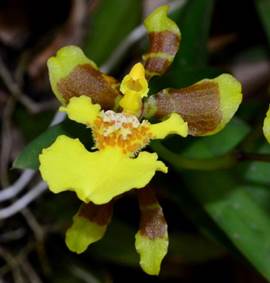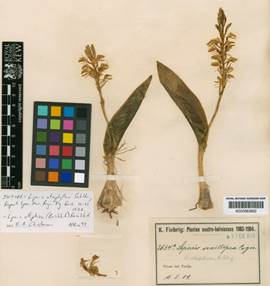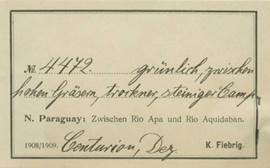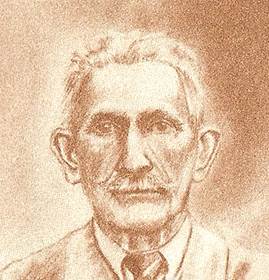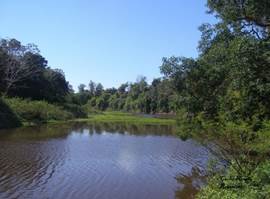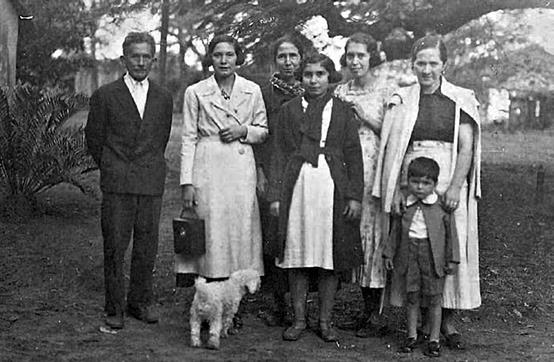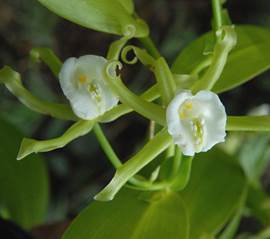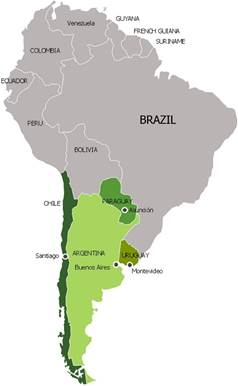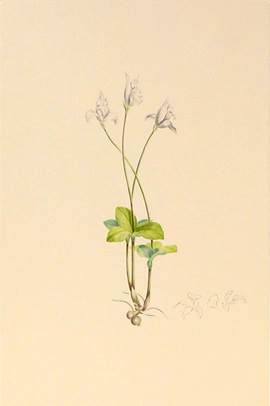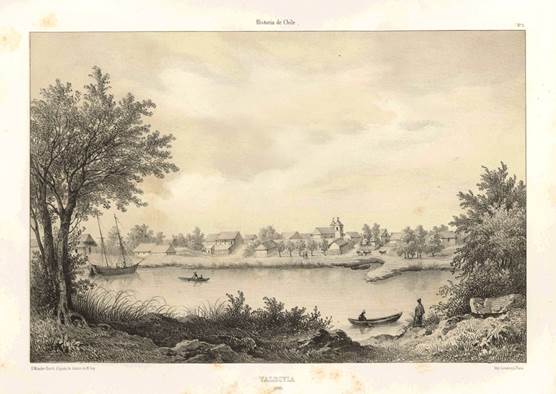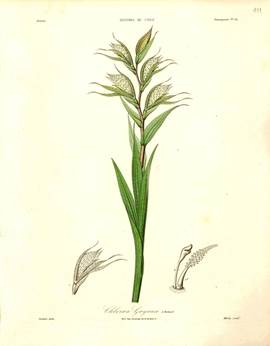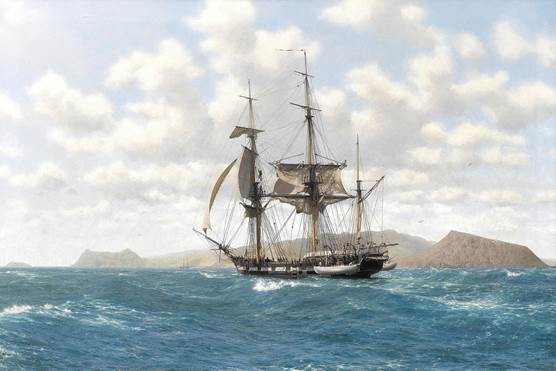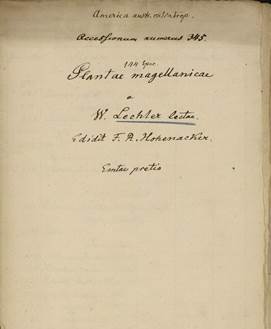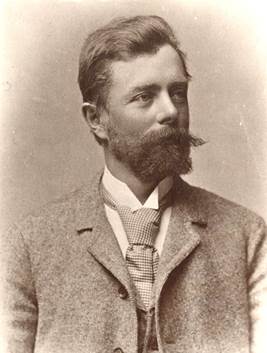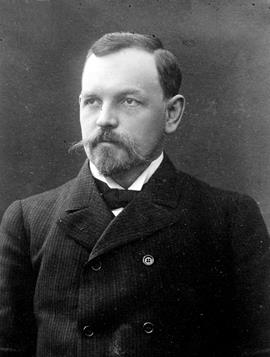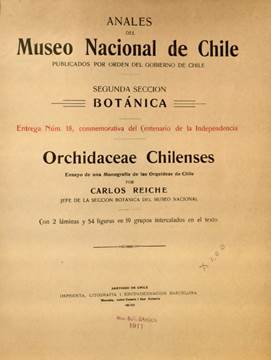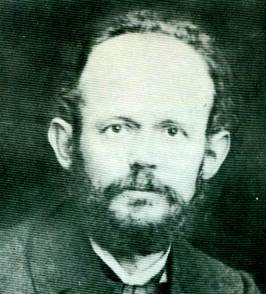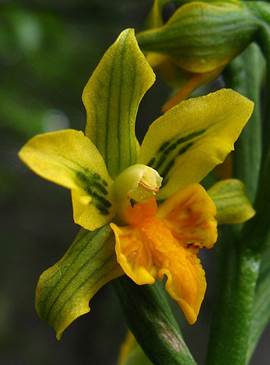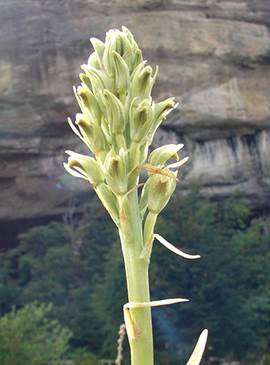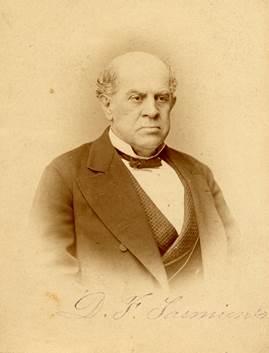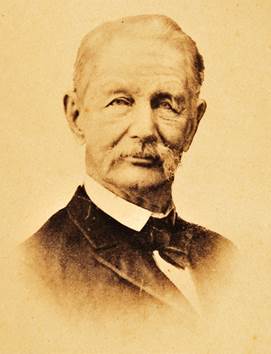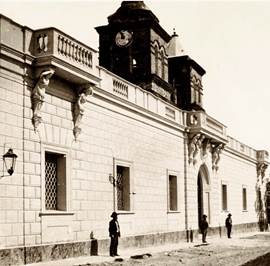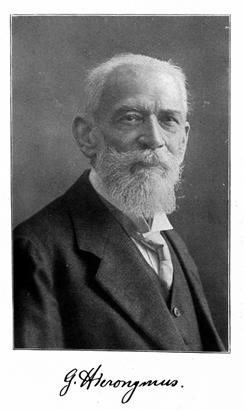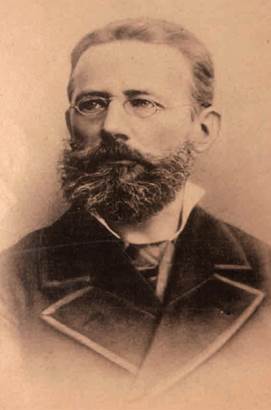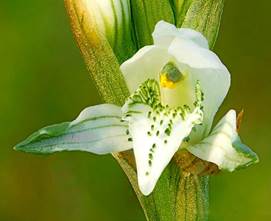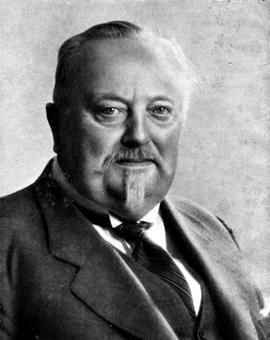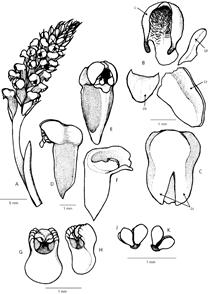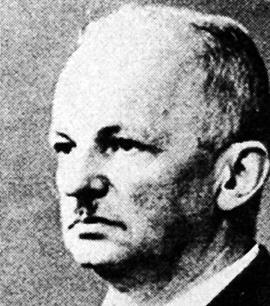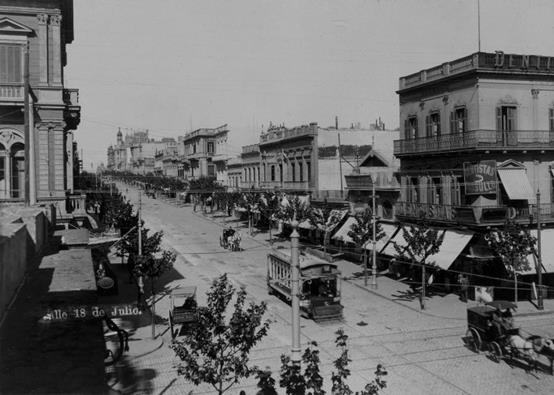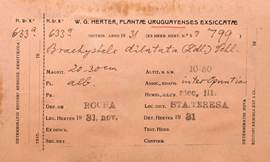Bolivia
The country is one of the two landlocked countries in South America (the other being Paraguay). It was named after Simón Bolivar (1783-1830) (Fig. 1), South America's great liberator and first President of Bolivia. It is bounded to the north and east by Brazil, to the south by Paraguay and Argentina, and the west by Chile and Peru. The country's topography includes the Eastern Andean Cordillera Oriental, which bisects Bolivia from south to north, and the Western Andean Cordillera Occidental, which runs along the border with Chile. The Cordillera Occidental features the extinct stratovolcano Nevado Sajama, at 6542 m (Fig. 2), Bolivia's highest peak.
Between the two mountain ranges lies the Altiplano, a highland plateau where Lake Titicaca is located. The lake is crossed by the border between Bolivia and Peru. To the east and north of the Cordillera Oriental are the valleys of the Yungas, a region of amazing scenic views, which slowly descends into the lowland plains of the Amazon Basin by what is called 'the most dangerous road in the world' (Fig. 3). The south-eastern part of the lowlands, on the border with Paraguay, is part of the Gran Chaco (Fig. 4), a sparsely populated hot and semiarid natural region of the La Plata River Basin, divided between Bolivia, Paraguay, Argentina and Brazil.
Bolivia is thus a country of extremes, whose extremely high biodiversity is the result of the great number of microclimates ranging from the Altiplano, at over 4000 m, to the Amazon Basin and the lowlands of the Gran Chaco (Fig. 5).
Botanical exploration 1750-1800: The botanical exploration of Bolivia began with Joseph de Jussieu (1704-1779), who had taken part in the expedition of La Condamine to Ecuador between 1735 and 1747. After the expedition disbanded, he travelled to Lima before moving to La Paz, in Bolivia, in 1750 where he spent the next five years (Ossenbach 2020). De Jussieu's collections are mostly labeled Perou, but without exact provenance. Since Bolivia did not exist as an independent state at this time and was part of the Viceroyalty of Peru, we cannot determine if there were any Bolivian plants amongst his specimens. The Czech Thaddaeus Haenke (1761-1816), after leaving the expedition of Alessandro Malaspina in the port of El Callao in 1790, intended to cross the continent and meet Malaspina again in Buenos Aires or Montevideo. Instead, he stayed in Bolivia and remained there for the rest of his life. He died in the city of Cochabamba in 1816. A large part of his botanical collections were described by Carl B. Presl in Reliquiae Haenkeanae in 1839 (Presl 1830).
Alcide D'Orbigny (1802-1857) botanized in Bolivia and border regions of Brazil for the Natural History Museum in Paris between 1830 and 1833. After him came Thomas Bridge (1807-1865), who arrived in Bolivia in 1844 and collected plants for the Kew Herbarium until 1846. Many new species found amongst his collections were described by Lindley in his Folia Orchidacea (Lindley 1852?). Hugh Algernon Weddell (1819-1877), a member of Castelnau's expedition, came from Brazil to Bolivia in 1845 and botanized in the country intermittently until 1851.
One of the most prolific orchid collectors in Bolivia was Gustave Mandon (1799-1867), who visited the country from 1848 to 1861. He collected a total of over 1800 specimens. The Orchidaceae were described in 1878 by Reichenbach f. in his Orchideae Mandonianae (Reichenbach 1878). Henry Hurd Rusby (1855- 1940) collected in 1885 and 1886 and was instrumental in interesting Miguel (Michael) Bang (1853-1896) in continuing his work. Bang made large collections of orchids from 1886 until his death ten years later. The results were described by Rusby in a series of articles entitled An enumeration of the plants collected in Bolivia by Miguel Bang, published by the Torrey Botanical Club between 1893 and 1896.
Finally, Carl Ernst Otto Kuntze (1843-1907) visited Bolivia during his second South American journey in 1892. Alfred Cogniaux described a total of four new species among his Bolivian collections.
Henry Hurd Rusby (1855-1940), Miguel (Michael) Bang (1853-1895 (1897?)) and Robert Statham Williams (1859-1945) (collected 1885 - 1886, 1884 - 1895, and 1901 - 1902, respectively)
Sent in 1885 by Parke, Davis & Co., once America's oldest and largest drug maker, on an expedition to Peru and Bolivia to gather supplies of coca leaves, Henry Hurd Rusby (1855-1940) (Fig. 6) was one of the pioneers in the advancement of pharmacy and medicine.
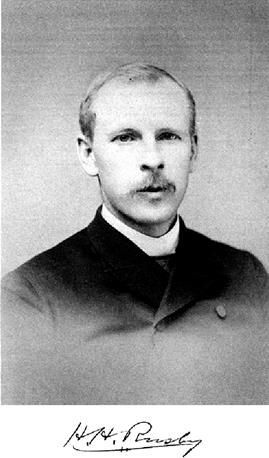
Figure 6 Henry Hurd Rusby (1855-1940). Botany Libraries of Harvard University. In Rossi-Wilcox, 1993: fig. 1.
Rusby had developed an early interest in botany and in 1871 began collecting plants in Essex County, New Jersey, under the guidance of C. H. Fuller. He was admitted to the Torrey Botanical Club and in 1880 was hired by the Smithsonian Institution to investigate the botany, natural history and archaeology of New Mexico. After returning from New Mexico in 1882, Rusby studied for a year at the College of Physicians and Surgeons of Columbia University and later at the Medical College of New York University, where he received a Doctorate in Medicine in 1884 (Rossi-Wilcox 1993: 1-4).
In January, 1885, Henry H. Rusby embarked in New York City for the port of Arica, in northern Chile. Over the next two years, he would cross the continent, botanizing in Peru and Bolivia before travelling down the Amazon to the Atlantic (Fig. 7). He returned to the United States with 45,000 botanical specimens, of which about 20% were new to science (Fig. 8).
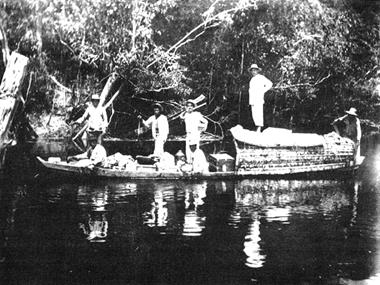
Figure 7 Henry H. Rusby in the Amazon Region, 1886. NYBG Library Archive. In Williams & Fraser, 2008: fig. 2.
Over the years Rusby would take part in several other expeditions to South America: in 1893 to the Orinoco Valley in Venezuela, in 1917 to the Magdalena River in Colombia, in 1919 to Bolivia and Brazil again, and finally as leader of the Mulford Biological Expedition to the Amazon Basin in 1921. However, he had to abandon this last expedition due to ill health and returned to the United States in December of that year.
Rusby travelled from Chile to La Paz in March 1885. He returned briefly to Valparaiso in Chile but in June was back in the capital of Bolivia. There he collected in the region of the Yungas and around of the village of Sorata, about 150 kilometers northwest of La Paz. In the first months of 1886, he left Bolivia and continued through Brazil to the Atlantic.
In 1890, Dr. Rusby was one of the first scientists to be appointed to the staff of the newly founded New York Botanical Garden, an association he maintained until he died in 1940. Simultaneously, he occupied the position of Dean of the New York College of Pharmacy at Columbia University and was Vice-president and then President of the Torrey Botanical Club.
Among Henry Rusby's collections of orchids, Schlechter described two new species: Elleanthus setosus and Habenaria yungasensis. Rolfe determined as new to science Liparis rusbyi, Oncidium rusbyi (Fig. 9), Pleurothallis rusbyi, Stelis rusbyi (collected by M. Bang for Rusby), and the new orchid genus Rusbyella (the only orchid genus endemic to Bolivia) with its type species Rusbyella caespitosa. Other species of this genus have been found in later years, among them Rusbyella aurantiaca by G. Gerlach and T. Franken (Fig. 10). Finally, Rolfe described Oncidium rusbyi.
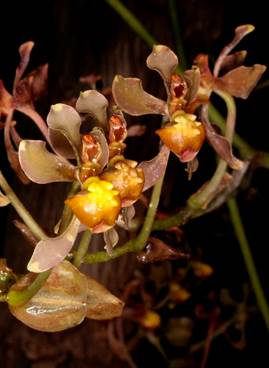
Photograph by Lourens Grobler.
Figure 9 Oncidium rusbyi Rolfe, as Cyrtochilum cimiciferum (Rchb.f.) Dalström.
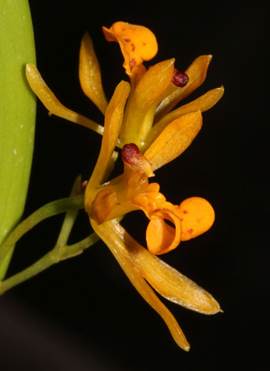
Figure 10 Rusbyella aurantiaca G.Gerlach & T.Kramer, as Cyrtochilum aurantiacum (G.Gerlach & T.Kramer) Dalström.
Henry Hurd Rusby's expedition to Bolivia would bring additional results: during his time in La Paz he met Bang, who worked in the suburbs of the city (Fig. 11), and a few years later came into an agreement with him to make extensive botanical collections. Fifteen years later, Rusby was again instrumental in securing botanical collections from Bolivia for the New York Botanical Garden by arranging the South American expedition of Robert Statham Williams (1859-1945). Both events would result in substantial contributions to our understanding of the Bolivian orchid flora.
In his enumeration of the plants collected in Bolivia published between 1893 and 1896, Henry H. Rusby wrote about Bang: ''The study of the Bolivian flora, as represented in the collections made by myself in the years 1885 and 1886, the enumeration of which is still proceeding in the pages of the Bulletin, proved so interesting to Dr. Britton and myself that we became very desirous of having the collections continued. An opportunity to gratify this desire was found in 1889, when Mr. Miguel Bang consented to carry on the work which I had begun. Mr. Bang is the son of a Danish clergyman, educated in gardening at Kew, who went to Bolivia somewhere about the year 1883, for the purpose of collecting and sending to England living orchids. The enterprise proving unsuccessful, Mr. Bang engaged in other pursuits in the vicinity of La Paz, where I met him in 1885, and formed the acquaintance from which the present arrangement has resulted. Since Mr. Bang began collecting, the work has been pushed as steadily as circumstances would permit. It was hoped that the proceeds from the sale of specimens would more than pay the expenses of collection, so that Mr. Bang might derive more or less profit from the enterprise; but unfortunately, such has not been the case. Despite every effort and economy, I have found it necessary to supply a considerable deficiency, while Mr. Bang has received nothing beyond his expenses. Indeed, owing to a lack of ready funds, it has not been possible to fully utilize the time in collecting.'' (Rusby 1893: 1).
No other biographical data are known about Miguel Bang. From his herbarium labels, Rolfe's descriptions and Rudolf Schlechter's brief historical account (Schlechter 1922), we gather that he collected from 1883 to 1890 in the vicinity of La Paz (the villages of Coripata and Coroico in the Yungas valleys are often mentioned). In 1891 we find him in Cochabamba, in 1892 in Tipuani and in 1893 at the Mapiri River. All these places are in the Department of La Paz.
By the time Bang met Henry Rusby, he had made already a substantial start on the classification of the Bolivian flora. He collected hundreds of new species and several unknown genera, described by H. H. Rusby in four separate instalments in the Memoirs of the Torrey Botanical Club. Bang's large collection of orchid specimens was studied and determined chiefly by R. A. Rolfe. Schlechter described additional species collected by Bang in his orchid flora of Bolivia (Schlechter 1922).
Duplicate sets from his herbarium were later distributed by Rusby and N. L. Britton to most of the main American and European herbaria. In his later years, Bang worked as Curator of Municipal Parks in Cochabamba and remained active in gardening for the rest of his life. The date given for Bang's death is usually 1895, but there are specimens at Kew bearing his name and dated 1897 (Fig. 12).
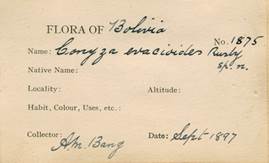
Figure 12 Herbarium label of Coryza evacioides Rusby, with collection date given as Sept. 1897. Kew Herbarium # 000221757.
Among the orchids collected by Bang, Schlechter described Epidendrum miguelii (Fig. 13), Habenaria bangii, H. miguelii, Masdevallia bangii (Fig. 14), Pleurothallis dolichocaulon, P. rophalocarpa, Scaphyglottis boliviana (Fig. 15), and Zygopetalum bolivianum (Fig. 16).
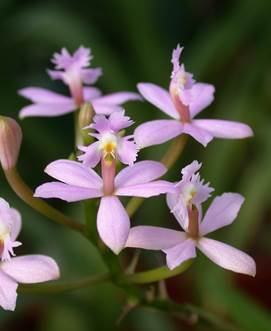
Photograph by Arne and Bernd Larsen.
Figure 13 Epidendrum miguelii Schltr. as Epidendrum ibaguense Kunth.
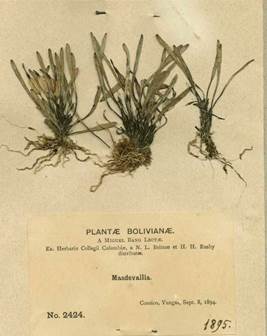
Figure 14 Masdevallia bangii Schltr. #2424 of a collection named Plantae Bolivianae a Miguel Bang lectae. Herbarium of Columbia University. Roy W. Squires.
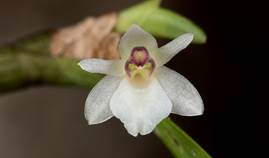
Photograph by Luis Pérez.
Figure 15 Scaphyglottis boliviana Schltr. as Scaphyglottis graminifolia (Ruiz & Pav.) Poepp. & Endl.
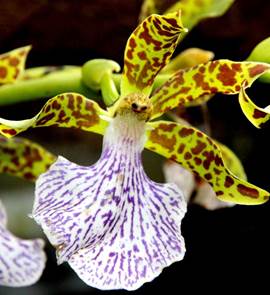
Photograph by Picasa.
Figure 16 Zygopetalum bolivianum Schltr. as Zygopetalum intermedium Lodd. ex Lindl.
Rolfe had previously described a large number of species of Orchidaceae collected by Bang in Bolivia (Rusby 1907), amongst them: Aganisia boliviensis, Epidendrum bangii, Masdevallia scandens (Fig. 17), Octomeria boliviensis, Pleurothallis britonni, Pterichis bangii, and Stelis bangii.
Robert Statham Williams (1859-1945) (Fig. 18) is the last in our trilogy of collectors for the New York Botanical Garden. Williams was born in Minneapolis, Minnesota. An adventurous person and fascinated by nature, he travelled to Montana as a young man, where, as a homesteader, he built the first cabin in what is today the city of Great Falls. He worked for twenty years as a businessman, miner and explorer and even served for short while as a rider for the Pony Express. It was during his time in Montana that he received a subvention from Columbia College, New York to collect bryophytes for Elizabeth Knight Britton.
In 1898, when the 'Gold Rush' began in the Yukon Territory in northwestern Canada, Williams joined one of the parties heading to the Klondike. He set himself up in business and made a small fortune. His spare time was spent collecting plants.
In 1899, Williams joined the newly created New York Botanical Garden, directed by Nathaniel Lord Britton (1859-1934). A few months later he brought his botanical collections to New York and, although the Museum Building was not finished and still lacked central heating, he spent the winter of 1899- 1900 living and working in it. He would remain in the employment of the Botanical Garden until he died 45 years later.
In his early years with the Garden, he went on several botanical expeditions: Bolivia and Peru in 1901- 1902, the Philippine Islands of Luzon and Mindanao in 1903-1905 and finally Panama in 1908. The rest of his life was spent studying mosses and publishing the results of his studies.
It is Williams' expedition to Peru and Bolivia which interests us here. It was significant as it was the first expedition to South America by a scientist on the staff of the New York Botanical Garden.
Martin Conway (1856-1937) (Fig. 19), a passionate British amateur naturalist and mountain climber, visited Peru and Bolivia in 1898-1900. He published a narrative of this expedition in 1901, under the title Climbing and Exploration in the Bolivian Andes. In it, he describes the journey from Lima to the Andes on the Oroya Railway (Fig. 20), and from there to Bolivia, where he climbed Mount Sorata and Mount Illimani.
With the idea of exploiting the country's vast mineral resources and its rubber production, he formed the Bolivia Company, which received the approval of the Bolivian Government to start operations in the country from 25 September 1900. Conway set up a team of British scientists to explore the Upper Amazon Basin in Eastern Bolivia but turned to the New York Botanical Garden for a botanical expert to form part of the expedition. Henry H. Rusby was involved in arranging the trip and Robert S. Williams was appointed to accompany the group. The number of plants later described by Rusby with the epithet conwayi suggests that Rusby was indebted to Conway. In later publications, Rusby often referred to Williams' trip as the ''Conway Expedition''.
Williams companions, namely, John W. Evans, geologist and head of the expedition, John Turle, mining engineer and G. N. Whatney, civil engineer, were all British subjects and members of the Bolivia Company. The group arrived at the Peruvian port of Mollendo on 4 August, 1901, took the train to Puno, crossed Lake Titicaca and continued by coach to La Paz, where they arrived on 14 August.
After two weeks in La Paz, planning for their first trip, the expedition went by mule over the Huallata Pass (4300 m) to the town of Sorata, 2000 m lower. From Sorata they followed the main trail to Mapiri and on 11 September arrived in Tolapampa. Another two-day travel brought them to Mapiri, where their equipment was transferred to cayapos (rafts, created by lashing together a number of logs). In September and October, they floated down the Mapiri and Beni Rivers before arriving in San Buenaventura. Here they left the rivers, and after three long months of marching through the most difficult terrain arrived back in La Paz at the end of May 1902. This was Williams' first trip.
Here the party broke up: Evans and Whatney returned to London and only Turle remained with Williams in La Paz. At the request of the Bolivia Company, they went to the village of Apolo, northeast of La Paz, to Sorata again and keeping to the northwest of their first route returned to Apolo and thence to La Paz (Fig. 21). Williams was on his way back to New York by mid-October. In total, and according to his notebooks, Williams made 2981 numbered plant collections in Bolivia and Peru (Fig. 22).
In 1912 and again in 1922, Rudolf Schlechter described several new orchid species from Williams' botanical collections and named some in his honour: Beloglottis boliviensis Schltr., Bulbophyllum bolivianum Schltr. (Fig. 23), Dichaea longa Schltr. (Fig. 24), Habenaria williamsii Schltr., Maxillaria boliviensis Schltr., Oncidium williamsii Schltr., and Trizeuxis andina Schltr.
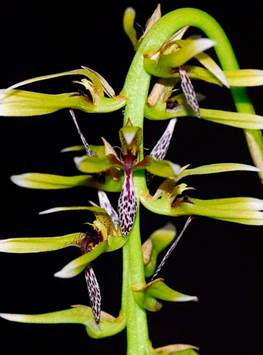
Photograph by Jay Pfahl.
Figure 23 Bulbophyllum bolivianum Schltr. as Bulbophyllum weddelii (Lindl.) Rchb.f.
Williams is commemorated in botanical nomenclature by the genera WilliamsiaMerrill (1908) (Rubiaceae), and Williamsiella E. G. Britton (1909) (Pottiaceae), as well as by the names of many plant species.
Otto Buchtien (1859 - 1946).and Ernst Carl Franz Günther (1870 - ?) (collected 1906 - 1936, together with Günther 1923 - 1927)
''In 1922 I published my work on the orchid flora of Bolivia and I could write that the name of Dr. Buchtien would always be named in first place in the history of the botanical exploration of the country. After the here described new botanical successes, it
becomes clear that nobody has ever done so much for the exploration of this Andean state''. (Schlechter 1929: 28).
Otto August Buchtien (1859-1946) (Fig. 25) was born in Rostock, where he studied Natural History and Mathematics and received his doctorate in 1887. After working for a few years as a private teacher, in 1893 he travelled as a teacher to Chile, where he would stay for the following 13 years. He began his botanical collections in Valparaíso and continued to southern Chile (province of Valdivia). Another excursion took him over the Pass of Uspallata, at over 4000 m (Fig. 26), to the Argentinian city of Mendoza and later to San Carlos de Bariloche, in the province of Rio Negro.
Buchtien collected a few terrestrial orchids in Chile and Argentina, among them Codonorchis poeppigii Lindl. from Valdivia (1887) (Fig. 27) and Chloraea piquichen Lindl. from San Carlos de Bariloche (1905). However, Buchtien's most important botanical collections were made after he was invited by the Government of Bolivia to organize the National Museum of Natural History in La Paz in 1906.
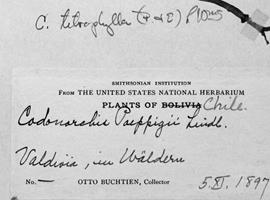
Figure 27 Buchtien herbarium label from Valdivia, Chile, 1897 (Codonorchis poeppigii Lindl.). United States National Herbarium.
Covering almost 135,000 km2, the Department of La Paz, one of the nine departments that form the Republic of Bolivia, extends from the heights of Lake Titicaca to the lowlands of the Amazon Basin. It has, therefore, a rich variety of climate and vegetation zones. As Director of the Museum, Buchtien had ample time to explore the region in all directions; during his thirty years in the country, he seldom ventured
outside this area. He amassed a large collection of botanical specimens and from the first day the orchids were his favourites.
Albert Spear Hitchcock (1865-1935) (Fig. 28), a well-known botanist and specialist in grasses from Harvard University and the New York Botanical Garden, was sent to Peru and Bolivia in 1923 to study the grazing industry. In Bolivia he could not have found a better guide than Otto Buchtien, who he mentions in his report of the expedition (Hitchcock 1925).
One of Hitchcock and Buchtien's excursions took them to the region of the Yungas; Hitchcock wrote: ''I had been in correspondence with Dr. Otto Buchtien, the well-known German botanist, long resident in Bolivia, who was then in southern Peru (Buchtien was at that time in Arequipa, on a collecting expedition with Ernst Karl Günther, see below). I was fortunate in having his company on my next trip, which was to the Yungas, the montaña region lying to the north and east of La Paz over the eastern Cordillera. Sr. Aramayo, the director general of the Yungas railroad, aided very efficiently by furnishing passes for Dr. Buchtien and myself to Pongo and mules and a man for our trip through the Yungas (…) Dr. Buchtien was widely acquainted in the region and we were able to stop at several plantations with his friends''. Hitchcock had previously collected several orchids in British Guyana and Ecuador but no orchid specimens are known from his journey to Bolivia. He is remembered in Epidendrum hitchcockii Hágsater & Dodson and Pleurothallis hitchcockii Ames.
Buchtien's excursions were sponsored by the Ministry of Colonization, but when the available funds ran out in 1935 Buchtien had to abandon his position at the Museum, returning to Germany the following year. Perhaps through contacts established during the visit of Albert S. Hitchcock, Buchtien was able to sell his entire herbarium to the United States National Herbarium.
In 1910, Buchtien published an important work on the flora of the country, Contribuciones a la Flora de Bolivia (Parte I). Further volumes were unfortunately never published. Only eleven orchid species were described here by F. Kränzlin, although Buchtien warned that at the time of publication many orchid specimens still awaited determination.
In 1908, Kränzlin described new species collected by Buchtien (Neue und kritische Arten) and again in 1928 (Orchidaceae novae Bolivianae).
Rudolf Schlechter determined an important number of Buchtien's orchids in 1912, under the title Additamenta ad Orchideologiam Bolivianum, which was followed in 1922 by additional specimens described in Orchideenflora von Bolivia and, posthumously, by Orchidaceae Buchtienianae in 1929.
Kränzlin and Schlechter described between them around one hundred and twenty new orchid species from Buchtien's collections. Among them, an important number were dedicated to Otto Buchtien; by Kränzlin: Catasetum buchtienii Kraenzl. (Fig. 29), Cycnoches buchtienii Kraenzl., Houlletia buchtienii Kraenzl., Sigmatostalix buchtienii Kraenzl. (Fig. 30), and Xylobium buchtienianum Kränzlin.
And by Schlechter: Cyrtopodium buchtienii Schltr. (Fig. 31), Dichaea buchtienii Schltr., Encyclia buchtienii Schltr., Epidendrum buchtienii Schltr., Habenaria buchtienii Schltr., H. ottonis Schltr., Macradenia buchtienii Schltr., Masdevallia buchtienii Schltr., Maxillaria buchtienii Schltr., Microstylis buchtienii Schltr., Notylia buchtienii Schltr., Octomeria buchtienii Schltr., Oncidium buchtienii Schltr., Physurus buchtienii Schltr., Pleurothallis buchtienii Schltr., Sobralia buchtienii Schltr., Stelis buchtienii Schltr., and Warmingia buchtienii Schltr.
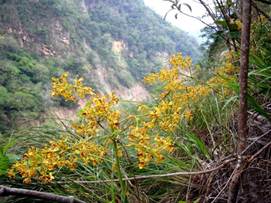
Photographed in situ in Bolivia by José Luis Panozo.
Figure 31 Cyrtopodium buchtienii Schltr. as Cyrtopodium virescens Rchb. f. & Warm.
In addition, Schlechter described a new genus, which he named Buchtienia, with the type species Buchtienia boliviensis Schltr. (Fig. 32).
''A German merchant, Herr Günther, kindly took me under his wing and made me his guest during the time of my stay. He owns an India-rubber forest in the Mapiri district.'' (Conway 1901: 200). Ernst Carl Franz Günther (1870-?) (Fig. 33) had established himself in the 1890s in the village of Sorata, to the northeast of La Paz, where he bought the famous residence of the Richter family. Günther belonged to a class of rich merchants with interests in the rubber industry and in mining, among whom Günther and Otto Richter ranked among the most prominent. Ernst Carl Günther was the owner of the Hacienda San Carlos, a rubber plantation with over 200 workers. But he was also a successful merchant, and imported luxury goods from Europe to Bolivia, which involved transportation along dangerous roads from the Pacific port of Arica to the Bolivian highlands (Fig. 34).
Otto Buchtien must have met Günther in Sorata in the early 1920s. In 1922, Schlechter described Dichaea buchtieni, collected by Buchtien in San Carlos, Mapiri, undoubtedly a reference to Günther's hacienda. Herrera (1939: 28) mentioned that Günther and Buchtien collected in 1923 in the hills of Mollendo, near Arequipa, Peru, which is coincident with Hitchcock's mentioning that Buchtien was in southern Peru at the time of his arrival in Bolivia (1923). And in his Orchidaceae Buchtienianae (1929), the majority of Buchtien's collections were labeled ''Mapiri'' or ''San Carlos''.
Buchtien was not only Günther's guest at Sorata, he also awakened in his countryman a love for nature and for orchids. In Buchtien's herbarium we find his own labels (''Dr. Otto Buchtien- Herbarium Bolivianum'' (Fig. 35)) and a separate section of plants collected by Günther with the label ''Ernesto Günther - Herbarium Bolivianum'', but always with the note ''legit. Buchtien'' (Fig. 36). This was undoubtedly a special arrangement between Buchtien and Günther of which nothing further is known.
In the final months of 1898, Ernst Günther, in partnership with another German, Franz Rehder, founded the ''Cervecería Alemana'' (''German Brewery'') in Arequipa, southern Peru. A long story of success followed, including the establishment of a new brewery, the ''Cervecería Cusco'', and the foundation of the ''Corporación Cervesur'' in 1926. Cervesur, managed by Günther's heirs, is today still in business and has become one of the most powerful corporations in Peru.
Despite his business commitments, Günther maintained his interests in Sorata and continued botanizing, organizing a very successful expedition in the first months of 1927, in the company of Otto Buchtien, to the district of Mapiri. The headquarters for this excursion was Günther's Hacienda San Carlos.
Several new orchid species were named in honour of Ernst Carl Günther. The first was Pleurothallis guentheri Schltr. (Fig. 37) collected around 1922- 1923 and described by Schlechter in his Orchidaceae Buchtenianae in 1929.All others were described by Kränzlin because they were collected in the above- mentioned expedition of 1927 after Schlechter's death; among them we find Catasetum guentherianum Kränzlin., Epidendrum guentherianum Kraenzl.. (Fig. 38), Habenaria guentheriana Kraenzl.., Maxillaria guentheriana Kränzlin., Octomeria guentheriana Kraenzl.., and Stenoptera guentheriana Kraenzl..
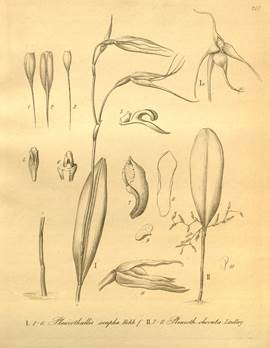
Figure 37 Pleurothallis guentheri Schltr. (right) as P. obovata (Lindl.) Lindl. Xenia Orchidaeae, vol. 3: plate 247.
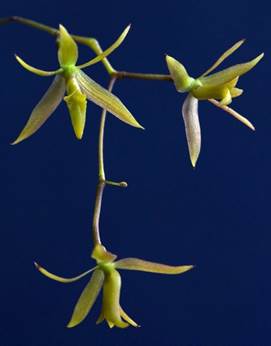
Photograph by Ecuagenera.
Figure 38 Epidendrum guentherianum Kraenzl. as Epidendrum compressum Griseb.
If you ever travel to Sorata, do not miss a visit to its town square. The city is proud of its beautiful gardens. Once there, you will find on one of the corners an old, somewhat run-down but still beautiful building. It is the old mansion built by Otto Richter in the last decades of the 19th century and later acquired by Ernst Carl Günther; it is, therefore, better known nowadays as ''Casa Guenther''. It is today a boarding house named ''Residencial Sorata''; a news reporter who once spent a holiday in the city called it ''the hotel where history never sleeps'' (Fig. 39).
Theodor Carl Julius Herzog (1880-1961) (collected 1907 - 1912)
Following a line of research like that of Dr. Otto Buchtien, Theodor Carl Julius Herzog (1880-1991) (Fig. 40) took upon himself the task of carefully studying and describing the different vegetation zones of Bolivia, especially in the regions on the eastern slopes of the Andes.
Herzog visited Bolivia twice. An Argentinian railroad company ('Sindicato del Ferrocarril del Oriente Boliviano') invited him in 1907 to take part as botanist in an otherwise purely economic expedition through eastern Bolivia. He took ship from Buenos Aires in March of that year to cross Paraguay to the Brazilian- Bolivian border at Puerto Suárez. He continued for several months through the province of Chiquitos until arriving in Santa Cruz in the month of June. He then travelled north to the Río Blanco, where he would report that the expected rubber and cinchona trees where not to be found. Having thus fulfilled his mission, he returned over the route from Cochabamba and Oruro to the Pacific port of Antofagasta. After travelling to Buenos Aires to deliver his report to the railroad company, he returned to Germany in February 1908.
His second expedition, this time financed by himself, extended from September 1910 to January 1912. Herzog travelled from Buenos Aires by train to Ledezma, the endpoint of the Argentinian Railroad, and continued on the Pilcomayo River over Villa Montes and Charagua to Santa Cruz, arriving in December 1910. He made Santa Cruz his headquarters for several months and explored the forest in the vicinity of the city until March 1911, when he left for Cochabamba (Fig. 41) to again explore the Cordilleras surrounding the city.
In September 1911, while in Cochabamba, Theodor Herzog met C. Seelig, a friend from Zürich - like Herzog an accomplished mountain climber to explore the Cordillera of Quimsa Cruz, southeast of Lake Titicaca. Together, Herzog and Seelig climbed several Bolivia's highest peaks (Fig. 42).
In the first days of November, Herzog, back in La Paz, ended his expedition. He then travelled over Oruro again to Antofagasta, before returning to Germany with magnificent botanical collections in January 1912. The botanical results of Herzog's second Bolivian adventure were published in 1923 as Die Pflanzenwelt der bolivianischen Anden und ihres östlichen Vorlandes (= The vegetation of the Bolivian Andes and their eastern foreland) (Herzog 1923, Schlechter 1922: 12, Mägdefrau 1962: 74). Orchids in this work are mentioned only in a very general way as lists of those genera that can be found in the different vegetation zones.
Rudolf Schlechter described 29 new orchid species collected by Herzog in Bolivia in the second part of his Additamenta ad Orchideologiam Bolivianam in 1913. Schlechter's descriptions of Herzog's orchids continued in 1916 and were published in Leiden as Die von Dr. Th. Herzog auf seiner zweiten Reise durch Bolivien in den Jahren 1910 und 1911 gesammelten Pflanzen with the descriptions of 31 new orchids. We find again Herzog's orchids in 1922 in Schlechter's vol. V (Bolivia) of his Orchideenfloren der Südamerikanischen Kordillerenstaaten; an additional species, Sarcoglottis herzogii, was published in 1925 in Schlechter's long series Orchidaceae novae et criticae (Schlechter 1925). Over 60 new orchid species were collected by Herzog in Bolivia.
The greater part of Herzog's botanical collections was made in the provinces of Santa Cruz and Cochabamba (Fig. 43), on the eastern slopes of the Andes descending to the Amazon basin, at elevations between 250 and 3000 m.
Schlechter named a dozen new orchid species in honour of Theodor Herzog: Epidendrum herzogii (Fig. 45), Habenaria herzogii, Masdevallia herzogii (Fig.46), Neodryas herzogii (Fig. 47), Oncidium herzogii (Fig. 48), Pachyphyllum herzogii, Physosiphon herzogii, Physurus herzogii, Pleurothallis herzogii, Sarcoglottis herzogii, Sobralia herzogii, and Stelis herzogii. Carlyle Luer followed suit in 1998 with Lepanthes herzogii.
Photograph by Eric Hunt.
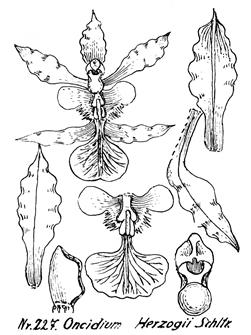
Figure 48 Oncidium herzogii Schltr. Analytical drawing by Schledchter in Schlechter & Mansfeld, 1929 plate 58, illustration 57.,
All of Herzog's new orchid species were collected during his second journey to Bolivia. His herbarium labels read: 'Plantae in itinere secundo per Boliviam lectae'.
Theodor Herzog moved to Zürich in 1914, where he worked during World War I (WWI) as a private lecturer. In 1920, he was offered a position as Professor of Botany at the University of Munich, the place where he had received his doctorate in 1903. Finally, from 1925 to his retirement in 1948, he held the chairs of Botany and Bryology at the Friedrich-Schiller University in Jena. He passed away in Jena on 6 May 1961.
Karl Pflanz (1872-1925) (collected 1907-1925)
A relatively minor figure in this story, Karl Pflanz (1872-1925) belonged to the category of amateur botanists to whom Rudolf Schlechter so often resorted to obtain new orchid material from South America. Born on the island of Rügen, off the German Baltic coast, he was the son of a wealthy factory and farm owner. He worked as a merchant in Berlin, Paris, London and Hamburg before travelling to Mexico, where he worked on several cattle farms and coffee plantations. In 1904, he continued to Argentina to study cattle-breeding and took a position with an Argentinian-Chilean trading company in 1905. He travelled widely through Argentina and southern Chile before moving to Bolivia in 1906. In 1915, he was appointed German vice-consul in Villa Montes, in the department of Tarija in southern Bolivia. At the same time, he became a partner of the German trading company Staudt & Co. During the period of inflation after WWI, he established a foundation in Germany which sponsored young researchers in botanical studies.
Karl Pflanz made botanical collections in Argentina and Bolivia which mostly went to the Botanical Museum in Berlin. He drowned on 20 April 1925 while crossing the Río Piedras near Salta, Argentina. His last botanical collection consisted of 150 herbarium specimens from Villa Montes, received in Berlin a few months before his death (Anonymous 1825, Frahm & Eggers 2001).
Among Pflanz's botanical specimens, Rudolf Schlechter determined three new orchid species, all named in his honour: Catasetum pflanzii, Cyrtopodium pflanzii (Fig. 49), and Encyclia pflanzii (Fig. 50).
Joseph (José) Steinbach (1875 - 1930) (collected 1913 - 1929)
José (Joseph) Steinbach (1875-1930) (Fig. 51), from the city of Lindlar, in the German state of North- Rhine Westphalia, went to South America in 1902, a member of a scientific expedition from the Museum of Sciences of the German Empire sent to explore northern Argentina. After two years he continued alone to Bolivia with the purpose of collecting objects of natural history, especially flora and fauna, and he would spend the next 25 years restlessly exploring that country. He established himself in the small village of Buena Vista, in the lowlands of the department of Santa Cruz, today the gateway to beautiful Amboro National Park (Fig. 52).
Steinbach, besides working as a farmer and cattle rancher, made a living by selling his natural history collections to museums and university herbaria around the world. Among his large botanical collections, more than 30 species were dedicated to him, including several orchids. He also collected zoological specimens in large numbers; the Carnegie Museum of Natural History in Pittsburgh acquired some 3000 bird skins from him in 1920. Steinbach's large collections remaining in Bolivia formed the basis of the Museum of Natural History in Cochabamba in 1930 (founded just before his death at the early age of 56); this comprised around 100,000 insects, a herbarium of 5000 different plant species, 800 birds, 140 reptiles and 100 mammals.
Having decided to spend the rest of his life in Bolivia, Steinbach married a Bolivian lady, Juana Moreno Jiménez, and raised a family of nine children. The family name is still well known in the country.
Steinbach gained considerable recognition both in Europe and the United States and corresponded extensively with scientists at the institutions to which he sent his collections. He became a member of the North American National Geographic Society in Washington, the Carnegie Museum of Pittsburgh and the American Museum of Natural History in New York.
The following orchid species were dedicated to José Steinbach: Encyclia steinbachii Schltr. (Fig. 53), Epidendrum steinbachii Ames (Fig. 54), Fernandezia steinbachii Ormerod., and Stelis steinbachii Luer. An avenue in the Bolivian city of Santa Cruz was named after him 'Avenida José Steinbach'.
Paraguay
Paraguay and Bolivia are the only landlocked South American countries. Paraguay borders Brazil (north and east), Argentina (south) and Bolivia (north and west). The Paraguay River, which flows from north to south, divides the country into distinct eastern and western regions that gently slope toward the Paraguay River. The eastern region, known as the Paraneña, extends from the Paraguay to the Paraná River, which forms the border with Brazil and Argentina. It is home to about 95% of Paraguay's population and is a mixture of plateaux, rolling hills and fertile valleys. Most of the region lies below 300 m elevation with a few higher points reaching 700 m near the northern border with Brazil. Dense forests cover the plateau of Alto Paraná, which occupies about one third of the region and extends to the east to the Paraná River. The Saltos del Monday (= falls of the Monday River, a tributary of the Paraná) (Fig. 55), are one of its most attractive geographic landmarks.
The western region, the Chaco Plain or Gran Chaco, is a tract of flat and infertile scrub forest. Along the banks of the rivers there are grassy plains and clumps of palms, but the land becomes drier toward the west and is almost desert in the northwest. It is divided among eastern Bolivia, western Paraguay, northern Argentina and a portion of the Brazilian states of Mato Grosso and Mato Grosso do Sul, where it is connected to the Pantanal, the world's largest wetland area, the main part of which is located in Brazil but it extends into Paraguay and Bolivia (Fig. 56).
Paraguay straddles the Tropic of Capricorn and experiences both tropical and subtropical climates.
Botanical exploration 1757-1885
Paraguay's geographical location, far from all trade and exploration routes during the 17th and 18th century, is the reason for it being virtually botanically unknown until the last decades of the 19th century. As to orchids, probably the earliest description of a new Paraguayan species was Reichenbach's Spiranthes paraguayensis (Reichenbach f. 1852: 230) (Fig. 57).
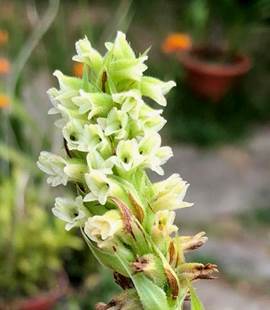
Phorotograph by Julio Omar Barcala.
Figure 57 Spiranthes paraguayensis Rchb.f. as Skeptrostachys paraguayensis (Rchb. f.) Garay.
The first scientific explorer of Paraguay was Louis Antoine de Bougainville (1729-1811), who had to interrupt his circumnavigation of the globe in 1767 in the port of Montevideo, where one of his ships had to undergo repairs. He used the time to visit Paraguay and the Jesuit missions. A member of Bougainville's expedition was the French botanist Philibert Commerson (1727- 1773), who would later discover some new orchids in Patagonia. Aimé Bonpland (1773-1858), Humboldt's companion during their famous expedition across northern South America, settled in the province of Mendoza in 1816, when it was a territory disputed by Argentina and Paraguay. Bonpland would dedicate himself mainly to the cultivation of yerba mate (Ilex paraguariensis A. St.-Hil.), still today the favourite drink of Paraguayans, Argentinians and Uruguayans. He remained in the region until his death in 1858. Agustin de Saint Hilaire (1799-1853) arrived in Rio de Janeiro in 1816 and remained in South America until 1821. During this time, he made several excursions to Paraguay and Uruguay, bud did not collect any new orchid species. After returning to France, Saint Hilaire published his Histoire desplantes le plus remarquables du Brésil et Paraguay (= History of the most noteworthy plants of Brazil and Paraguay) (Saint-Hilaire 1824). Unfortunately, only one of two planned volumes was ever published, and we must assume that the family Orchidaceae would have been included in the second one. Finally, Alexander Caldcleugh (1795-1858), merchant, miner, botanist and mineralogist, travelled across Brazil, Argentina, Uruguay, Paraguay, Chile and Peru between 1819 and 1821. No botanical collections from him are known from Paraguay.
Hassler, Emil (1861-1937) (Collected 1895-1937)
Born in Aarau, in Swiss-German-speaking Switzerland, Emil Hassler (1861-1937) (Fig. 58) attended the elementary and secondary schools of his hometown and afterwards studied medicine in France. Before finishing his studies, he moved to Brazil, where he obtained his degree at the University of Rio de Janeiro (Hochreutiner 1939: 1). In 1884, he began practicing medicine in Cuiabá, the capital city of the state of Matto Grosso, where he soon began exploring the region pursuing his initial ethnographical interests. After three years in Cuiabá, Hassler moved to Paraguay in 1887 to take a position as a physician at a hospital in San Bernardino, near the capital Asunción.
Hassler's interests soon turned to botany and his first collections were made in 1895 and 1896 (Vischer 1938). After a short interlude in Switzerland, he returned in 1897 to Paraguay settling in San Bernardino, where he built his first house in a suburb popularly known as the Bierschlucht (= Beer canyon) as it mostly housed German immigrants. He travelled regularly to Switzerland, where in 1898 he published the first part of his series Plantae Hasslerianae in the Bulletin de l'Herbier Bossier (Geneva); further parts were published through 1907 (Chodat & Hassler 1898).
Hassler's plants were determined by Robert Hippolyte Chodat (1865-1934), a Swiss botanist and phycologist, who was director of the botanical institute at the University of Geneva. Chodat established a close personal relationship with Hassler that lasted to the end of his life. In his botanical excursions, Hassler always travelled with his assistant Teodoro Rojas and often with German botanist Cornelius Osten. We will read of both further on in this chapter.
An important milestone in Hassler's life was the visit of Robert Chodat and his assistant William Vischer to Paraguay, in what was known as the Mission scientifique Suisse au Paraguay. Hassler had returned in the meantime to Switzerland but was happy to join his friends. From July 1914, over the following three months, Hassler, Chodat and Vischer explored the country in all directions (Fig. 59-60). They returned to Switzerland with a rich botanical collection which, as with most of Hassler's plants, was deposited at the herbarium of the Conservatory and Botanical Garden in Geneva.
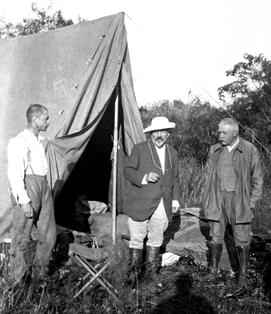
Unknwon photographer.
Figure 60 From left to right: R. Vischer, E. Hassler, R. Chodat in Paraguay (1914).
In 1919, after WWI, Hassler returned to Paraguay, built a new home in San Bernardino, which he named Villa Mon Repos ('My resting place'); he would remain there for the rest of his days (Fig. 61) apart from occasional trips to Switzerland on short visits for scientific or medical purposes.
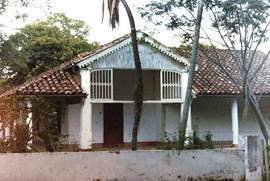
Photograph by Lorenzo Ramella.
Figure 61 Hassler's Villa Mon Repos in 1987, two years before being demolished.
In 1921, Hassler took part in the foundation of the Sociedad Científica del Paraguay (Scientific Society of Paraguay), of which he became honorary President. In 1932, during the Chaco war between Paraguay and Bolivia, he established and directed a hospital for the wounded in San Bernardino and was awarded the honorary rank of a Colonel in the Paraguayan army. The hospital was closed in 1935 at the end of the war. Emil Hassler returned one last time to Switzerland before he died two years later in Asunción. He is buried in the cemetery of San Bernardino.
It is estimated that 90% of Paraguay's botanical species are represented in Hassler's collections. About 13,000 different species can be found there, with a total of some 60,000 specimens. Hassler's botanical collections constitute, without doubt, the foundation of scientific knowledge of the flora of Paraguay. A complete catalogue of these collection, including other collectors' related specimens from Paraguay, have been published as Catalogus Hasslerianus (Ramella & Perret 2008-2010); this includes many new species published in the Plantae Hasslerianae as well as in subsequent publications by Emil Hassler and others. Hassler's specimens were extremely well prepared and include all parts necessary for identification.
The Herbarium of the Geneva Conservatorium and Botanical Garden holds a total of 18,263 botanical specimens collected by Emil Hassler in Paraguay. Of these, a surprisingly low number are Orchidaceae: only 371 orchid specimens. However, 19 of these orchid specimens represent species which were new to science, 10 of which were named in honour of Hassler. They were mostly described by Alfred Cogniaux but a few of them were contributions by Rudolf Schlechter.
For 160 years Paraguay was a possession of the or der of the Jesuits. They named it in Spanish 'Provincia Paraguaria' (in Latin Paraqvaria) and it was one of the southernmost provinces of the Viceroyalty of Perú. A beautiful map of the province was made in Rome by Giovanni Petroschi (1715-1766), which was dedicated to Francisco Retz (1673-1750), Superior General of the Society of Jesus. It bears the Latin inscription Provincia Paraquariæ Soc, Jesu, anno 1732 (Fig. 62).
The name 'Paraguaria' has been used in scientific circles up to the present, and this is the reason for Hassler labelling his botanical specimens as Plantae Paraguariensis (Fig. 63).
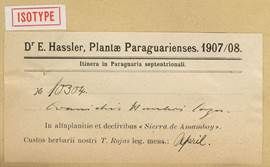
Figure 63 Cranichis hassleri Cogn. Hassler herbarium label, Plantae paraguariensis 1907-1908. MNHN Paris.
Emil Hassler's new orchid species include: Campylocentrum hasslerianum Hoehne, Cranichis hassleri Cogn., Epidendrum hassleri Cogn. (Fig. 64), Galeandra paraguayensis Cogn. (Fig. 65, 66), Habenaria amambayensis Schltr. (Fig. 67), H. hassleriana Cogn. (Fig. 68), H. integripetala Cogn., H. subfiliformis Cogn., Oncidium emilii Schltr., Oncidium hassleri Cogn. (Fig. 69), Pogonia hassleriana Cogn. ex Chodat & Hassl., Ponthieva hassleri Schltr., Sarcoglottis hassleri Schltr., Spiranthes hassleri Cogn., Stenorrhynchos albicans Cogn., S. pedicellatus Cogn., S. vaginatus Cogn., S. ventricosus Cogn., and Zygopetalum hasslerianum Kränzlin.
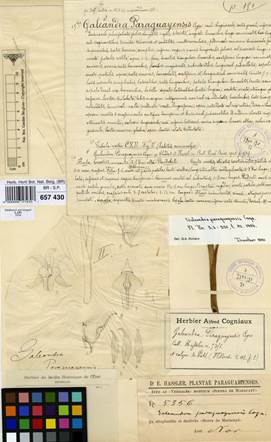
Figure 66 Holotype of Galeandra paraguayensis Cogn. Herbarium of the Belgian National Botanical Garden.
Karl August Gustav Fiebrig (1969-1951) (collected 1902-1951)
Kränzlin was responsible for sowing some confusion when he published his Orchidaceae andinae imprimis peruvianae Weberbauerianae in 1906. It is only by chance that the reader will find in this article not only the description of new orchid species that were not collected by Weberbauer, but that were not even collected in Peru! Together with Weberbauer's orchids we find five new species collected by Karl August Gustav Fiebrig (1902-1951) (Fig.70) in southern Bolivia.
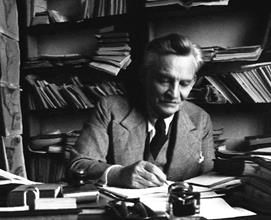
Unknown photographer.
Figure 70 Karl August Gustav Fiebrig (1869-1951). At the Ibero-America Institute in Berlin around 1940.
Fiebrig studied natural history in Berlin under Adolf Engler, and it was Engler who sent him to South America in 1902 on a scientific expedition on behalf of the Botanical Garden and Museum of Berlin (Schuurmans Stekhoven 1955: 151). Fiebrig travelled across Paraguay to southern Bolivia, where he made his botanical collections. He also made important observations on the phytogeography of Bolivia, which he would publish in 1911 as Ein Beitrag zur Pflanzengeographie Boliviens ('A contribution to the geography of plants in Bolivia') (Fiebrig-Gertz 1911); this would serve Rudolf Schlechter in his description of the Bolivian orchid flora (Schlechter 1922). Like Kränzlin before him, Schlechter described seven new orchid species from Fiebrig's Bolivian collections.
Amongst Fiebrig's Bolivian orchids, described by Kränzlin, are: Chloraea boliviana, C. calantha, C. fiebrigiana, C. ignea, and Stenoptera elegans. Schlechter described Aa fiebrigii, A. microtidis, A. sphaeroglossa, Galeandra fiebrigii (Fig. 71-72), Habenaria bermejoensis, H. leptantha, Liparis otophyllon (Fig. 73), Pelexia fiebrigi, and Pterichis boliviana as new to science.
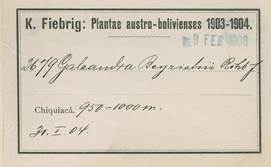
Figure 71 Herbarium label of an isotype of Galeandra fiebrigii Schltr. Fiebrig determined this plant as Galeandra beyrichii Rchb. f. Royal Botanic Gardens Kew. The collection is from Fiebrig's first South American excursion to Bolivia.
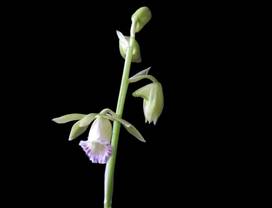
Photograph by Luis Filipe Varela.
Figure 72 Galeandra fiebrigii Schltr. as Galeandra beyrichi Rchb.f.
Afflicted by tuberculosis, Fiebrig remained in South America and moved to San Bernardino, in Paraguay, where he would live and work over the next thirty years.
The year 1910 was pivotal in determining his professional future. He received two offers simultaneously: the first was to work in East Africa for the German Colonial Office; the second, the Government of Paraguay offered him a chair at the 'Colegio Nacional' and at the Faculty of Medicine. Fiebrig decided to accept the Paraguayan offer, moved especially by an additional proposal by Paraguay's President, D. Manuel Franco, to establish a Botanical Garden and Zoo in the suburb of Trinidad, in Asunción, the capital.
The garden, designed in collaboration with his wife Anna Gertz, was finally inaugurated and opened to the public in 1914, during the Presidency of Eduardo Schaerer. It encompassed over 600 hectares and became soon a popular attraction (Fig. 74). Fiebrig gave the garden the Guaraní name Yboty rendá, 'the place of flowers', and remained in his position as Director until 1936. The University of the German city of Marburg awarded him an honorary doctorate in 1923 for his work in South America.
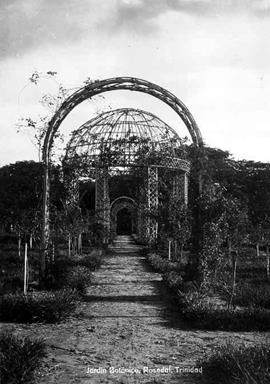
Unknown photographer.
Figure 74 Rose garden at the Botanical Garden in Asunción ca. 1920. In Junta Municipal de la ciudad de Asunción, 2014: 39.
On the premises of the Botanical Garden stood the second residence of Carlos López, the original owner of the land. This was built around 1860 as a two-story structure called 'la Casa Alta' (the high house) (Fig. 75), to differentiate it from the original house built ca. 1845, a single-story structure aptly known as 'la Casa Baja' (the low house). While the 'Casa Baja' today houses the Natural History Museum, the 'Casa Alta' was occupied by the Herbarium, the collection of plants in spirits, and offices where Fiebrig, Hassler and Teodoro Rojas worked. It was also Fiebrig's residence. He contributed to the herbarium with a large collection of plants from Paraguay and neighbouring countries. In the following years the collections were enriched by the contributions of Teodoro Rojas and Cornelius Osten.
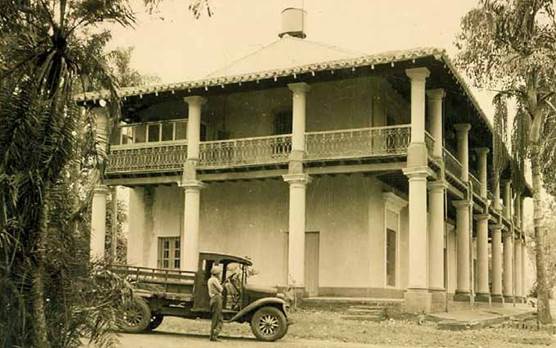
Unknown photographer.
Figure 75 'La casa alta' (the high house). In Junta Municipal de Asunción, 2014: 12.
For a short period, from 1934 to 1936, Fiebrig was also Director of the Paraguayan Department of Agriculture. He gave up this position to return to Germany as professor at the 'Ibero-Amerika Institute' in Berlin. After the war, in 1948, he returned to South America to work at the 'Instituto Miguel Lillo', a branch of the National University at Tucumán, Argentina, where he died on 25 October 1951.
Karl Fiebrig's botanical work in Paraguay concentrated mainly of the expansion and consolidation of the Botanical Garden in Asunción. He certainly contributed to the flora of Paraguay with large numbers of herbarium specimens; there were, however, very few new species among them (Fig. 76). The International Plant Names Index shows only five plant species described by Fiebrig.
As to orchids, both the Geneva Herbarium and Ratmella & Perret's Catalogus Hasslerianus (vol. 1, 2008) show over a hundred orchid specimens collected by Fiebrig. Despite this, there was only one new orchid collected by him, originally described by Slazchetko (1995) as Pelexia collocaliae (Fig. 77).
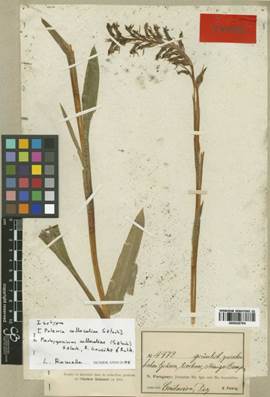
Figure 77 Type of Pelexia collocaliae Szlach. Herbarium oif the Geneva Consdervatorium and Botanical Garden.
Karl Fiebrig's magnum opus, a 2700 page-long manuscript on the vegetation of South America, remained unpublished after his death.
Teodoro Rojas Vera (1877-1954) (collected 1902-1954)
Born in Asunción, Teodoro Rojas Vera (1877- 1954) (Fig. 78) was the son of Jose M. Rojas and Dolores Vera. He studied at national schools in Pilar and Limpio, near San Bernardino. After failing to gain admittance at the Colegio Nacional in Asunción, he returned to San Bernardino, where he worked at the local German Brewery.
In 1887, when Emil Hassler moved to work at the hospital in San Bernardino, Teodoro's mother went to work as his housemaid and Teodoro, then only 11 years old, was hired by Hassler as gardener. This was the beginning of a long and close relation between the Swiss scientist and Teodoro Rojas, who would become one of Paraguay's most relevant botanists.
Ten years later, in 1897, Teodoro was invited by Hassler, then in Geneva, to study herbarium techniques at the Geneva Conservatorium and to research the large collections of the herbarium. He learned German and it is said that he always spoke it with a strong Swiss accent. After returning to Paraguay, he accompanied Hassler on numerous botanical expeditions across the country. His first herbarium specimens were prepared in 1906, during his participation in the Argentinian-Paraguayan Pilcomayo River Border Commission (Fig. 79).
Teodoro Rojas collected for Hassler and took part in the botanical excursions with R. Chodat and W. Vischer in 1914. In 1915, he accompanied Cornelius Osten, a German botanist residing in Montevideo, on a long excursion along the Paraná River and to the Iguazú Falls.
In 1916, he was offered the position of Chief of the Botanical Section at the Botanical Garden of Asunción, of which Karl Fiebrig was the first director. Rojas organized the herbarium, including those of Hassler, Fiebrig and his own collections. While Fiebrig lived in the 'Casa Alta' of the Botanical Garden, Rojas moved with his family into a modest house only a few blocks away (Fig. 80).
Rojas continued exploring the country and increased his botanical collections, although the Botanical Garden entered a period of decline as a result of a series of military interventions that led to continuous changes in the Government of Paraguay. His career was overshadowed by military administrators. Fiebrig was deposed from the directorship and left Paraguay in 1936, never to return. In 1944, Teodoro Rojas moved to Argentina, where he worked for the Instituto Miguel Lillo, in Tucumán; he would be joined in 1948 by Karl Fiebrig.
Near the end of his life, Rojas returned to Paraguay, where in 1952 he was awarded the title of Doctor Honoris Causa by the University of Asunción. He passed away in Asunción on 3 September 1954. Since 1993, the scientific journal of the Department of Botany of the National University of Asunción carries de name Rojasiana in his honour.
A total of 79 orchid specimens collected by Rojas are deposited at the Geneva Herbarium as collected by 'E. Hassler & T. Rojas'; among them is the type speci men for Epidendrum hassleri Cogn. (Fig. 81). The last line at the bottom of the label reads in Latin: Custos herbarii nostrii T. Rojas leg. mens April, which translates as 'The curator of our herbarium T. Rojas collected this in the month of April'.
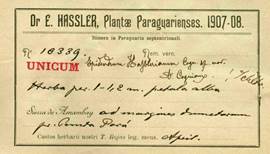
Figure 81 Herbarium label of Epidendrum hassleri Cogn. collected buy Hassler and Rojas. Geneva Herbarium.
Other new orchids collected by Rojas and dedicated to him were Bulbophyllum rojasii L.O.Williams (Fig. 82), Epidendrum rojasii Cogn. (Fig. 83), Microchilus rojasii Ormerod, and Vanilla rojasiana Hoehne (Fig. 84) (Schinini 2005, 2010).
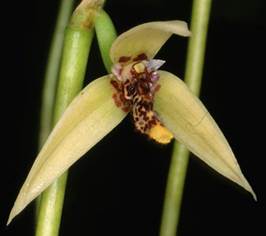
Photograph by Rudi Hromniak.
Figure 82 Bulbophyllum rojasii L.O.Williams as Bulbophyllum tripetalum Lindl.
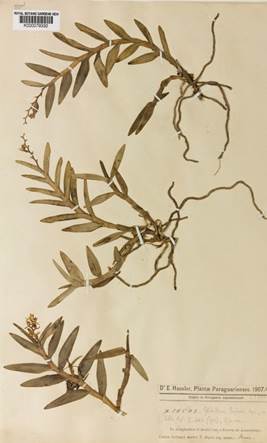
Figure 83 Type of Epidendrum rojasii Cogn. Reproduced with the kind premission of the Kew Botanic Gardens.
The Southern Cone
The Southern Cone (Fig. 85) is a geographic and cultural region, composed of the republics of Argentina, Chile and Uruguay, and in its broadest definition also Paraguay and the southernmost states of Brazil. The territory is located mostly south of the Tropic of Capricorn; to the west is the Pacific Ocean, and on the east is the Atlantic Ocean.
In this chapter we will consider the Southern Cone in its strict definition, and include only Chile, Argentina and Uruguay because all other South American countries have been covered in this and the previous chapters of the series.
Geography
The southern cone of South America, with its tip pointed towards Antarctica, is a region of over 1.5 million square miles (more than 4 million km2) that includes territory in the republics of Chile, Argentina and Uruguay. The Tropic of Capricorn crosses it in the north. By virtue of its position, it contains high western lands and low eastern lands of middle latitudes, with a marked influence from the Atlantic Ocean and a succession of climates from tropical in the north to cold in the extreme south. In the west rise the imposing Andean and associated mountain ranges. The cold waters of the Pacific bathe the coasts of Chile, forming deserts. The climatic and regional diversity provides abundant resources and various alternatives for the development of a complex biodiversity.
Towards the east, the 'pampas' or grasslands of the Southern Cone consist of temperate prairies and savannas, shared by Argentina and Uruguay. To the north of Argentina and bordering Uruguay and Bolivia, the Chaco region is a system of plains crossed by important river systems. To the south, Patagonia extends from the Colorado River to the region of Tierra del Fuego, which Argentina shares with Chile. South America's Arid Diagonal, a zone of arid and semi-arid climate, crosses from the desert of Atacama in northern Chile across the mountain chain of the Andes to the Atlantic coast of Patagonia.
In Chile, the central region south of Atacama has a Mediterranean climate and the desert gives way to fertile valleys that reach as far as the Region of the Lakes, with its capital Puerto Montt, in the south. Chilean Patagonia is very similar to its Argentinian counterpart, and both countries come together on Tierra del Fuego, on the shores of the Strait of Magellan.
Botanical exploration
The botanical exploration of the Southern Cone began with the journey of Louis Éconché Feuillé (1660-1732), who collected plants between 1703 and 1711 around the Chilean city of Concepción. Several remarkable terrestrial orchids were collected by Feuillé in southern Chile (Fig. 86).
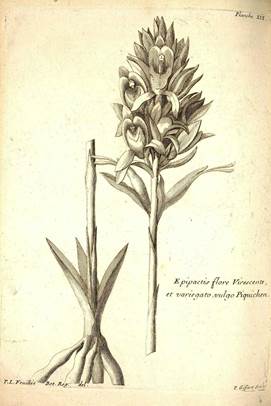
Illustration by Louis Feuillé.
Figure 86 Epipactis vulgo piquichen as named by Feuillé: Chloraea piquichen Lindl.
Daniel Carlsson Solander (1733-1782) sailed with Joseph Banks in 1768 as part of Captain James Cook's expedition to the South Pacific. They landed in Tierra del Fuego in 1769, where they collected a terrestrial orchid which they named Arethusa trifolia (= Codonorchis lessonii (Brogn.) Lindl.) (Fig. 87).
Philibert Commerson sailed as botanist in the expedition led by Louis Antoine de Bougainville , which set out from the French port of Nantes in 1767 to circumnavigate the globe. Their first stop was Rio de Janeiro, where Commerson discovered the beautiful Bougainvillea spectabilis Willd., a plant that would soon spread across the New and Old-World tropics and would thus perpetuate the name of the expedition's commander. The expedition sailed south to Montevideo and in 1767 was in Tierra del Fuego. They continued along the Strait of Magellan to Chilean Patagonia in 1768 and then set course to Taihiti. Commerson collected orchids in Brazil, Uruguay, southern Argentina and Chile. We remember him in Bipinnula commersonii Lindl., from Uruguay and Chloraea commersonii Brongn. from Chile.
José Pavón (1754-1844) was a member of the famous Spanish Botanical Expedition to the Viceroyalty of Peru between 1777 and 1788. Pavón travelled from Peru to Chile in 1782. He collected Chloraea pavonii Lindl., one of the most beautiful species of this terrestrial genus (Fig. 88).
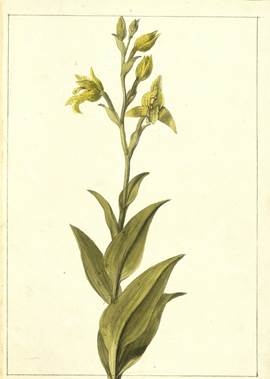
Illustration by José Brunete, one of the artists of the expedition. At the Royal Botanic Garden, Madrid, AJB, Div. IV, 1318.
Figure 88 Chloraea pavonii Lindl.
Louis Neé (ca. 1734-1807) sailed as botanist with the expedition of Alessandro Malaspina to the Pacific. He made botanical collections on the way, among which we find Epidendrum elongatum Jacq. and Oncidium oblongatum Lindl. from Uruguay and a species of Spiranthes from Chile.
John Miers (1789-1879), a British mining engineer and amateur botanist, came to the Argentinian city of Mendoza in 1818 before settling for a while in Chile. Years later, in 1856, he published an enumeration of the vernacular names given to several Chilean terrestrial orchids.
Carlo Giuseppe Luigi Bertero (1789-1831), having visited during a first expedition the Caribbean islands, crossed the Atlantic again in 1827 and settled in Chile, where he botanized in the surroundings of Valparaíso. Several species of Orchidaceae are kept at the Museum of Natural History in Santiago, among them two new species dedicated to him: Asarca berteri Rchb.f. and Chloraea berteroana Kränzlin. Hugh Cuming (1791-1865) travelled along South America's Pacific Coast in 1828, where he collected an important number of Chilean orchids, several of which were described as new to science by Lindley in his Catalogue of the Orchideae in Mr. Cuming's collection of South American Plants (Lindley 1834).
French Rear Admiral Jules Sébastien César Dumont d'Urville (1790-1842) sailed from the port of Toulon in 1822 with the mission of circumnavigating the globe. Part of the expedition was the pharmacist René-Primevère Lesson (1794-1849). The expedition touched at the Falkland Islands, where a new orchid species was collected: Calopogon lessonii Brongn. They continued to Chile, where again several orchid species were collected.
James MacRae (1800-1830) sailed from London in 1824 on the HMS Blonde to convey the remains of the Hawaiian monarchs back to their islands. King Kamehameha II and Queen Kamamalu had developed measles during an official visit to England and passed away only a few weeks after their arrival. During their return journey, the expedition stayed for several weeks in the vicinity of Concepción, in southern Chile. Macrae collected several orchid species from which Lindley described no less than six that were new to science.
In the southern suburbs of Buenos Aires, Argentina, the Scottish colony of Monte Grande was established in 1825. Among the 200 Scots selected to settle in the new colony was the gardener James Tweedy (1775-1862), who would be the first botanist to explore Argentina, in the first third of the 19th century. His excursions took him through Uruguay and northwards along the Brazilian coast to Rio de Janeiro, and later southwards to Patagonia until he reached Bahia Blanca. Next, he crossed the country westwards, to Tucumán and the cordilleras. On his return to Buenos Aires, Tweedie was surprised that his acquaintances did not recognize him, so rundown was his appearance after the hardships of his journey (Ossenbach 2020: 555-556). Several new orchids were collected by him, some named later in his honour: Spiranthes bonariensis Lindl. from Argentina and Uruguay, and Octomeria tweediei Luer & Toscano, and Stelis tweediana Lindl. from Brazil.
One of the most important botanical explorers of South America, Eduard Friedrich Poeppig (1798- 1868) grew up in Leipzig, where he studied medicine. In 1822, he departed on an expedition to the Americas. After a few years in Cuba and the United States, he travelled to Chile in 1826 and went on to Peru and Brazil, being only the third European, after Francisco de Orellana in 1542 and Charles Marie de la Condamine in 1744, to travel the entire length of the Amazon. The account of his South American journey, Reise in Chile, Peru und auf dem Amazonenstrome, während der Jahre 1827-1832, was published in two volumes (Poeppig 1835,1836). His major botanical work, Nova genera ac Species Plantarum quas in regno, Chiliensi, Peruviano, ac Terra Amazonica, anni 1827 - 1832 lectarum, was published in three volumes between 1835 and 1854 . It describes 528 species, including 31 new genera and 477 new species, many of which were beautifully illustrated (Fig. 89). For the first two volumes he was aided by Austrian botanist Stephan Endlicher. From Chile, Poeppig and Endlicher described the new orchid genus Gavilea and 22 species of orchids new to science.
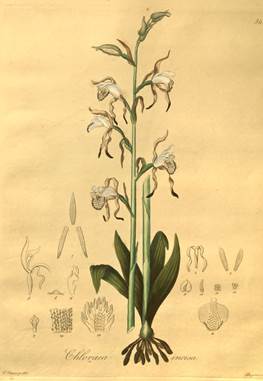
Figure 89 Chloraea incisa Poepp. Collected by Poeppig near Antuco, Chile. In Poepp. & Endl., 1835-1854 plate I-54. :
Claude Gay (1800-1873), after having abandoned the idea of studying medicine in Paris, went to Chile in 1828 to teach physics and natural history at a college in Santiago. He accepted a position as a researcher for the Chilean government in 1829 and in 1830 was one of the founders of the National Natural History Museum. After a short trip to France, he returned to Chile in 1834 and began writing his multi-volume Historia Física y Política de Chile, published by the Chilean government between 1844 and 1871. An Atlas to this history was published in 1854, containing not only landscapes (Fig. 90) and scenes of daily life in Chile but also beautiful illustrations of the most relevant plants of Chile's flora (Fig. 91).
Gay travelled to Peru in 1839 and returned to France in 1843. Subsequently, he travelled throughout Russia and Tartary and in 1858 was sent by the French Academy of Sciences to the United States to study the mining system. In 1863, he travelled for the last time to Chile, where he would remain until his death ten years later. Besides Chloraea gayana A.Rich, illustrated here, Asarca gayana was dedicated.to him by Kuntze.
Charles Gaudichaud Beaupré (1789-1854) travelled between 1830 and 1832 to Brazil, Argentina and Chile, where he collected several species of Chloraea.
Rudolf Amandus Philippi (1808-1904) came to Chile in 1851, where he would stay for the rest of his life. He established himself in Valparaíso and from 1853 to 1897 occupied the post of Director of the National Natural History Museum, a position he passed on to his son Friedrich when he retired. At the same time, he was Professor at the National University and made extensive botanical explorations of the country. It is said that he collected some 20% of all vascular plants known to Chile. He has been recognized as one of Chile's great naturalists: his name lives on in the orchid species Asarca philipii Kuntze, Chloraea philipii Lindl., and Epidendrum philippii Rchb.f. He also described some 50 new orchid species from Chile. Rudolf's son Friedrich (Federico) Philippi (1836-1910) was, like his father, an avid botanical collector. Only a few orchid specimens are known from his son's collections, however, none of them new to science.
Between 1832 and 1835 Charles Robert Darwin (1809-1882) sailed aboard HMS Beagle (Fig. 92) along the costs of Argentinian Patagonia, Tierra del Fuego and the shores of the Strait of Magellan. After entering the Pacific, the Beagle sailed north along the coast of Chile. During his voyage, Darwin collected several orchids, among them: in Patagonia, Chloraea gaudichaudii Brongn. at Port Desire (Argentinian Patagonia), Chloraea magellanica Hook.f. and Codonorchis lessonii (Brogn.) Lindl. (Straits of Magellan and Tierra del Fuego); and Bipinnula fimbriata (Phil.) I.M: Johnst. (Valparaíso, Chile). A signed pencil drawing by Darwin graces the sheet of a Gavilea at Kew.
Philibert Germain (1827-1913), a French entomologist, arrived in Chile in 1850 and was named interim director of the National Natural History Museum until the appointment of Rudolf Amandus Philippi in 1853. Apart from a short interlude in France, Germain would live in Chile until the end of his life. He made important botanical collections and several new orchid species, such as Habenaria germainii were described by Philippi from Germain's specimens.
Willibald Lechler (1814-1856) collected in southern Argentina, the Falkland Islands and Southern Chile from 1850 to 1854. His plants were distributed in Europe by Swiss botanist Rudolph Friedrich Hohenacker (1798-1874), advertised as 'W. Lechler plantae insularum Maclovianarum', 'W. Lechler plantae magellanicae' (Fig. 93), and 'W. Lechler plantae chilenses'. From Lechler's collections Lindley described a new orchid which he named Cholarea lechleri.
Finally, two French expeditions explored southern South America: that of Paul Amédée Ludovic Savatier (1830-1891), on board the Magicienne (1877-1879), and that of Paul Auguste Hariot (1854-1917), Paul Daniel Jules Hyades (1847-1919) and Philippe Hahn (?-?) aboard the Romanche (1882-1883). They collected a few orchids in Tierra del Fuego and southern Chile
This list of botanical collectors in the Southern Cone does not pretend to be complete. A selection was made, taking into consideration those botanists who had shown especial interest in orchids.
Once leaving the tropics and travelling south into the subtropical climate of the Southern Cone, orchid diversity drops immediately. While the northern neighbours of Chile, Argentina and Uruguay count their orchid species by the thousands, the total number of Orchidaceae in these three countries barely reaches 300 species. This is perhaps one of the reasons why Rudolf Schlechter showed relatively little interest in this region.
Chile
Perl Karl Hjalmar Dusén (1855 - 1926) (collected 1895 - 1897)
Per Karl Hjalmar Dusén's (1855-1926) (Fig. 94) first encounter with the South American flora took place between 1895 and 1897, when he was appointed as palaeontologist of the Swedish Expedition to the Magellan Territories led by Otto Nordenskjöld (1869-1928) (Fig. 95). In his report on the expedition Nordenskjöld wrote: ''The interest that has manifested itself of late in exploration in Antarctic regions was the impulse that gave rise to the Swedish expedition to the Magellan territories in 1895. At a time when the eyes of the whole geographical world were turned towards that portion of the earth, it seemed only fitting that Sweden's sons and explorers, who have had so important and extensive a share in opening up the north polar territories, should be prepared to participate in similar labours in the south, for we may confidently expect results obtained there to elucidate many of those already established for the north, placing them in their right light and showing their true value and application'' (Nordenskjöld 1901).
Dusén sailed from Buenos Aires in October 1895, made a short land excursion in Puerto Madryn and continued to the Strait of Magellan, arriving in Punta Arenas, on Chile's southern coast, in November. Punta Arenas would be the expedition's headquarters. Several short journeys took Dusén to Admirality Sound, the Páramo Penísula and the village of Ushuaia before he sailed back to Europe in the summer of 1897.
Although Dusén's work was mainly of a paleontological nature, he also made botanical collections and published an interesting account of the Vascular plants of the Magellan Territories and a contribution to the Flora of eastern Patagonia (Dusén 1900). A total of three orchid species were mentioned in this work: Chloraea commersonii Brong. and Chloraea magellanica Hook. f., and Codonorchis lessonii (d'Urv.) Lindl.
Allthough Dusén would return once more to Patagonia in a new expedition in 1905 -without significant botanical results- he made his largest contributions to the orchidology of South America while living in Brazil between 1901 and 1916.
Karl (Carlos) Friedrich Reiche (1860 - 1929) (collected 1889 - 1911)
In the introduction to his series on the orchid floras of the South American Andean states, Schlechter wrote: ''Since -not too long ago- a quite useful orchid flora of Chile was published by K. Reiche (Reiche 1910) ;, I have decided not to write another account of the orchids of this country, especially since few noteworthy novelties could be expected (Schlechter 1919: 3). Schlechter was right: Reiche, in his Orchidaceae Chilenses of 1910 (Fig. 96) lists 75 different orchid species distributed in 7 genera. One hundred and seven years later, after many species were transferred back and forth from one genus to another and some fell into synonymity, Bevilacqua (2017), in her article about Chile's orchid flora, lists 72 species, in eight different genera. This is again an example of the well-known fact that while in the epiphytic world of tropical orchids dozens of new species are discovered and described every year, it often takes decades until a new species is found among the subtropical terrestrial orchids. Schlechter not only described Microstylis reichei among the orchids collected by Reiche during his time in Mexico, but used his work often as reference, which is the reason why Reiche is mentioned as an indirect member of Schlechter's network.
German botanist Karl Friedrich Reiche (1860- 1929) (Fig. 97), or Carlos as he was known, was head of botany at the National Museum of Natural History in Santiago, Chile. He worked to organise the treasury of specimens deposited at the museum at this time, especially those from the collections made by Rudolf Amandus Philippi and his son Friedrich, by Claude Gay and by Carlo Luis Bertero during the better part of the 19th century. Born in Dresden, Saxony, Reiche studied the natural sciences, gaining a Ph.D from the University of Leipzig in 1885. He occupied a position as Professor at the same university between 1886 and 1889. The Chilean government contracted him to teach mathematics, physical and natural sciences and illustration at the recently founded school in Constitución, about 260 km southwest of Santiago in the region of Maule. He took up this post in 1889 and from the first day began to study the Chilean flora, a subject to which he would dedicate the next twenty years. Reiche undertook numerous excursions throughout the country, collecting specimens and conducting investigations for future publications. He was appointed as head of botany at the National Museum of Natural History in 1896 and moved to Santiago to work at their herbarium under the direction of Rudolph Amandus Philippi. Reiche began studying the ample collections contained there, including those of Philippi and his son Federico, preparing taxonomic revisions for what would be his most important work: the Estudios críticos sobre la Flora de Chile. With the help of Federico Philippi and F. Johow, he completed and published six volumes, but the work was interrupted when Reiche left Chile in 1911 (Turrill 1920: 63). Unfortunately, the treatment of the Chilean Orchidaceae was among those parts that were never completed.
In 1911, Carlos Reiche was chosen to be the next director of the museum, after the death of Federico Philippi the year before, but he turned this down since he did not agree with the policies set by the by the Chilean authorities of that time. Instead he accepted a post offered to him by the Mexican government. This was unfortunate because Reiche's knowledge of the museum and its collections was unparalleled at the time.
Reiche was professor of botany at the Mexican School of Higher Studies from 1911 to 1924, when he returned to Germany and took a position in Munich as a researcher at the Staatssammlung Museum. Aside from a brief return to Mexico in 1926 to complete his teaching and research, he remained in Munich and was named curator of the phanerogamic collections at the same museum in 1928, the year before his death. Reiche is commemorated in the epithet of the genus Reicheella Pax (Hectorellaceae).
In his Orchidaceae Chilenses of 1910, Reiche described several new orchids from Chile, namely Asarca cardioglossa Phil. ex Reiche, Asarca grandulifera var. illapelina Reiche, A. littoralis Reiche (Fig. 98), Chloraea leptopetala Reiche (Fig. 99), and Chloraea viridiflora var. reticulata Phil, ex Reiche.
In addition, Carlos Reiche illustrated the flowers of 17 Chilean orchids (Fig. 100) in the same work. However, the quality of the illustrations is not of the highest standard.
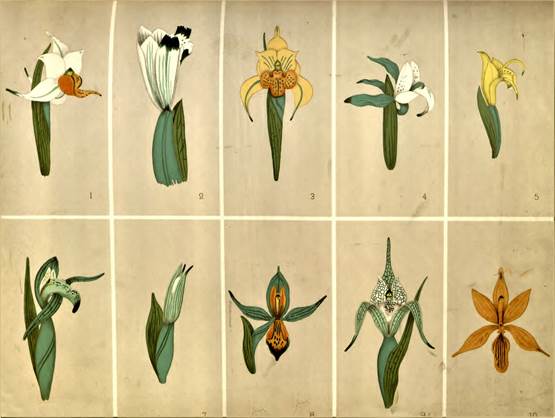
1. Asarca sinuata Lindl.
2. Chloraea ulanthoides Lindl.
3. Asarca odoratissima Poepp. & Endl.
4. Chloraea galeata Lindl.
5. Chloraea multiflora
6. Chloraea cylindrostachya Poepp.
7. Chloraea fonckii Phil.
8. Chloraea disoides Lindl.
9. Chloraea grandiflora Poepp.
10. Chloraea nudilabia Poepp
Figure 100 Plate IReiche, 1910.
Little more can be said about Schlechter's network in Chile, besides the previously mentioned orchids collected by Per Hajlmar Dusén.
Argentina
The Faculty of Exact, Physical and Natural Sciences at the National University of Córdoba, Argentina (various collectors 1870-1896)
Domingo Faustino Sarmiento (1811-1888) (Fig. 101) served as President of the Republic of Argentina from 1868 to 1874. He gave great impulse to the modernization of the country. He paid special attention to the improvement of communications and built infrastructure that included 5000 km of telegraph lines across the country. He was also responsible for the construction of the so-called Red Line, a railway connecting the interior of the country with Buenos Aires to bring goods to its harbour and facilitate trade with Great Britain. Sarmiento's main achievement, however, concerned his promotion of education. He increased educational subsidies to the provincial governments and established over 800 educational institutions. By the end of his presidency over 100,000 children were attending school. In 1869, shortly after assuming the presidency, he passed a law enabling the Executive to hire up to twenty professors to teach sciences at the University of Córdoba (Acosta 2015: 75). Sarmiento approached Karl Hermann Konrad Burmeister (1807-1892) (Fig. 102), a German naturalist who was Director of the Public Museum of Buenos Aires, to take on the responsibility of engaging German scholars for this task.
Burmeister accepted and immediately began appealing to his contacts in Germany to convince a number of young German scientists to abandon their positions and travel to Argentina to create the new Science Faculty. The first to accept were Paul Lorentz (Botany), Carl Schultz-Sellack (Physics), Hendrik Weyenbergh (Zoology), Max Siewert (Chemistry), Christian August Vogler (Mathematics) and Alfred Stelzner (Mineralogy) (Fig. 103). They all arrived between 1870 and 1873, when the first students were received and teaching could begin (Fig. 104). Georg Hans Emmo Wolfgang Hieronymus (1846-1921) (Fig. 105) arrived in Córdoba in 1872 as assistant to Lorentz.
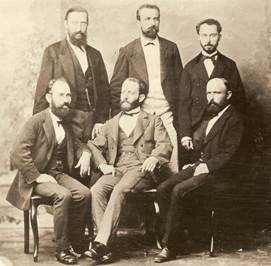
Figure 103 From left to right, standing: Paul Lorentz, Carl Schultz-Sellack, Hendrik Weyenbergh; sitting: Max Siewert, Christian August Vogler, and Alfred Stelzner
Soon after Lorentz arrived in Córdoba he was joined by Stelzner and, since the Faculty was not yet in condition to begin classes, they travelled north-east at the invitation of Federico Schickendantz (1837-1896) (Fig. 106), a German Chemist who had arrived in Argentina some ten years earlier and was a professor at the National College at Tucumán.
Born in Kahla, Saxony, Paul Günther Lorentz (1835-1881) originally studied Theology but changed his mind and went to the University of Munich, where he received his doctorate in Botany in 1860. He arrived in Córdoba in 1870. His first botanical excursion with Stelzner, which lasted five months, took him through the provinces of Santiago del Estero, Tucumán and Catamarca. Lorenz brought a large collection of vascular plants, which he sent to Grisebach for determination. Of these, 923 were published by Grisebach as Plantae Lorentzianae in 1874 (Grisebach 1874, Vervoorst 1972: 66). Only two orchids were mentioned in this work: Oncidium batemannianum Parment. and Stenorrhynchus speciosus Rich.
Lorentz lost his position at the University in Cordoba in 1874, after strong differences of opinion with the new Minister of Culture. Georg Nieronymus was named Professor of Botany in his place. Lorentz then moved to the small town of Concepción, on the banks of the Uruguay River. The new government under President Nicolás Avellaneda appointed him as professor at the local school, and he seemed to have regained a comfortable economic position. His health, however, had deteriorated and, although he was still able to publish a small work on the vegetation of the north-eastern regions of the province of Entre Ríos and took part in the 1879 expedition led by General Roca to the Río Negro, he never recovered. He died in Concepción in the first days of October 1881 (Stelzner 1882: 463-468).
Georg Hieronymus arrived in Cordoba in September 1872 at the age of 26. He had studied medicine and natural sciences at the universities of Zürich, Berlin and Halle before being chosen to assist Paul Lorentz, whose position he assumed after Lorentz was dismissed in 1874. During his years in Córdoba, he travelled a few times to Germany until in 1883 he decided to leave Argentina. He settled in the German city of Breslau and continued his botanical studies. He was later named curator of the Botanic Museum in Berlin under the direction of A. Engler. After difficult years during WWI, during which he lost his wife and his eldest son, he passed away in Berlin in January of 1921.
Immediately after the arrival of Hieronymus in Córdoba, Lorentz organized a second expedition with his new assistant. This would take them to the northwest for the next 16 months. Lorenz was again to visit the provinces of Catamarca and Tucumán, but this time Salta, Tarija and San Lorenzo as well. Just as after Lorentz's first expedition of 1871, the botanical collections were sent to Grisebach, who described 2,263 plants in a second work: Symbolae ad floram Argentinae, published in 1879 (Grisebach 1879). Several new orchid species described therein must be attributed to both Lorentz and Hieronymus. Among them we find: Chloraea biserialis. Cranichis micrantha (Fig. 107), Sigmatostalix brachycion, Spiranthes saltensis (Fig. 108), Spiranthes sellilabris, and Stenorrhynchus argentinus. Aa lorentzi was dedicated by Schlechter to Lorentz from a collection in the Sierra of Tucumán. Kränzlin dedicated Habenaria hieronymi to Hieronymus, and Cogniaux would follow with Altensteinia hieronymi and Microstylis hieronymi.
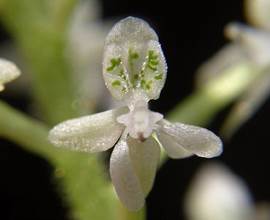
Photograph by Amerigo Docha Neto.
Figure 107 Cranichis micrantha Griseb. =Cranichis candida (Barbosa) Cogn.
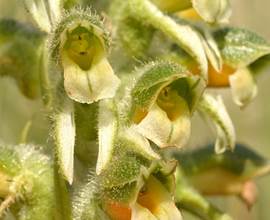
Photograph by Maria Ogrzewalska.
Figure 108 Spiranthes saltensis Griseb. as Pelexia bonariensis (Lindl.) Schltr.
Although only a minor figure in this story, a final word must be said about Friedrich (Federico) Schick- endantz (1837-1896). Born in Landau, in the Rhineland, he studied chemistry in Heidelberg, Munich and Oxford. He decided to go to Argentina in 1861, where he joined a mining company for a term of ten years. He taught physics and chemistry at the 'Colegio Nacional' of Tucumán, was director of 'Oficina Química Municipal' and became a member of the National Science Academy in Córdoba. He was about to take charge of the 'Oficina Química' in Mendoza when he died in 1896. Schickendantz developed a secondary interest in botany, specializing in cacti. He also amassed an herbarium of vascular plants from which Schlechter described and named in his honour the new orchid species Aa schickendanzii.
Carlos Luigi Spegazzini (1858 - 1926) (collected 1881 - 1925)
A leading figure in Argentinian natural history, Carlo Luigi Spegazzini (1858-1926) (Fig. 109) was born on 20 April 1858 in Bairo in Torino, northern Italy. He took courses at the school of Viticulture and Oenology in Conegliano (Venice), where he graduated in 1879. Thinking that botanical studies in Italy were well covered and completed by other botanists, he decided to explore other countries and sailed to Argentina and in December 1879, disembarking in Buenos Aires. In 1881, soon after his arrival, he took part in Lieutenant Santiago Boves' expedition to Tierra del Fuego. After numerous adventures, including swimming ashore with his botanical collections after a shipwreck, he returned to Buenos Aires in September 1882 with a collection of over 1100 botanical specimens.
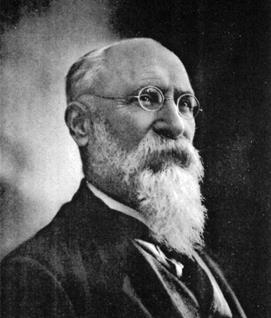
Figure 109 Carlo Luigi Spegazzini (1858-1926), in a photo taken on his 65th birthday. In Katina et al. 2020: 183.
In 1884, he was one of the founders of the La Plata National University. He took the position of Professor of Natural Sciences, Agronomy, Chemistry and Pharmacy and created the university's botanical garden and arboretum. Over the years, he would intensify his botanical collecting, taking part in over 20 expeditions, some of them taking him as far as Brazil, Paraguay and Chile.
The American mycologist William A. Turrill, who visited Spegazzini in his residence in La Plata in 1924, wrote this beautiful biographical note: ''Dr Spegazzini is an old man, but strong in body, young in thought, and still full of the spirit of adventure. He has just returned from Tierra del Fuego, is planning to go to Europe next year, and promises me to come to the United States the following year 'if nothing happens'. He was born in a village in Italy and was a student of the fungi there before coming to Argentina. He has described a great many South American plants in various groups, but his work is poorly known elsewhere and few of his specimens have been seen by other botanists. The Doctor is exceedingly genial in manner and very kind- hearted. He and his son stayed with me all day long, showing me specimens, photographs and publications; giving me anything I wanted for our herbarium; taking me out to a sportsman's club for lunch; visiting the museum; and going on a short collecting trip in the woods. We talked French, German, English, Latin and Spanish indiscriminately and recklessly, keeping up a continuous flow of conversation lest our ignorance in certain languages be discovered'' (Murrill 1924).
According to Katina et al. (2020), a total of 11 new orchid species were described by Spegazzini, many in co-authorship with Kränzlin: Chloraea albo-rosea Kraenzl. ex Speg., Chloraea chica Speg. ex Kraenzl. (Fig. 110), Chloraea cholilensis Speg. & Kraenzl., Chloraea hookeriana Speg. & Kränzlin. (Fig. 111), Chloraea hystrix Speg. & Kraenzl., Chloraea phoenicea Kränzlin. & Speg., Chloraea pleistodactyla Kränzlin. & Speg., Chloraea praecincta Speg. & Kraenzl., Pleurothallis aurantio-lateritia Speg. & Kraenzl., Restrepia cogniauxiana Speg. & Kränzlin. (Katinas et al. 2020: 197). Epidendrum argentinense Speg. & Kränzlin. was collected by his son Rutile A. Spegazzini.
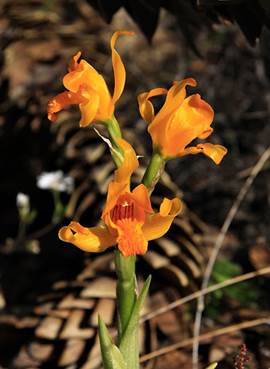
Photograph by Hernán Tolosa.
Figure 111 Chloraea hookeriana Speg. ex Kraenzl. As Chloraea alpina Poepp.
Several other orchid species were named in Spegazzini's honour: by Kränzlin, Chloraea spegazziniana, Habenaria spegazziniana, Leochilus spegazzinianus (Fig. 112), and Maxillaria spegazziniana: and by L. O.Williams, Pleurothallis spegazziniana.
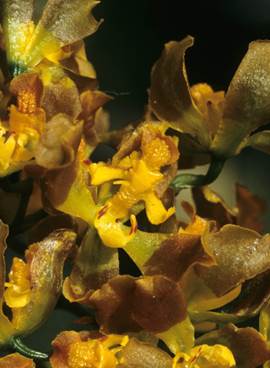
Photograph by K.H.Senghas.
Figure 112 Leochilus spegazzinianum Kraenzl. = Gomesa brieniana (Rchb.f.) M.W.Chase & N.H.Williams.
It may seem somewhat far-fetched to include Lorentz, Hyeronimus, Schickendantz and Spegazzini in Schlechter's 'network'. However, we consider that their botanical collections contributed to Schlechter's knowledge of the Argentinian orchids. Not only did Schlechter have the opportunity to study Grisebach's herbarium at Göttingen, but additional material reached him at the Berlin Botanic Garden through Kränzlin and Hieronymus. The species determined by Schlechter and dedicated to Lorentz and Schickendantz, as well as modifications of several of Kränzlin's determinations, such as the names Aa hieronymi (Cogn.) Schltr. and Oncidium spegazzinianum (Kraenzl.) Schltr., are proof of this.
The arrival in Argentina of European scientists in all disciplines was a phenomenon that began with President Sarmiento in 1864 and continued well into the first decades of the 20th century.
The story of Rudolf Schlechter's network of orchid collectors in South America is close to its end. We began with Schlechter's men in the southern states of Brazil and through 322 pages we travelled north across the Amazon basin and into the three Guyanas. We then turned west, across the mighty Orinoco and the Magdalena River through Venezuela and Colombia, turned southwest into Ecuador and Peru, and, after crossing the tropic of Capricorn in Bolivia and Paraguay, arrived finally in the southern cone, where we now will talk about Schlechter's collectors in Uruguay; after this we can consider the circle closed.
Uruguay
At just over 176,000 km2, Uruguay is the smallest country in South America after Surinam. Only about 50 different species of orchids in 13 genera can be found in its territory and only two noteworthy names of local botanists can be mentioned in relation to Schlechter's network. Both were of German origin.
Cornelius Osten (1863 - 1936) (collected 1885 - 1934)
The German botanist Cornelius Osten (1863- 1936) (Fig. 113) was born in the northern German city of Bremen. He had shown a great passion for botany from childhood and at the age of 22 emigrated to South America, where he lived in the province of Buenos Aires, Argentina. He built a successful business as an import-export merchant, an activity he maintained throughout his life. In 1887, he moved to Uruguay which would become his country of adoption.
Osten took part in excursions to the Argentinian provinces of Córdoba and Mendoza with his brother, the astronomer Hans Osten, and started amassing a herbarium, which by 1907 already contained 2000 specimens. However, his most fruitful travels were in Paraguay with Emil Hassler and his student Teodoro Rojas in 1914-1915. He sent many duplicates of his collections to the museums of Berlin-Dahlem (where they first caught the attention of Rudolf Schlechter), Washington and Buenos Aires. Osten was known as extremely open-minded, always directing his efforts toward improving the quality of his knowledge in all areas of the sciences, arts and geography; he also had a good knowledge of classical languages. Cornelius Osten worked with the famous Spanish-born botanist José Arechavaleta (1838-1912), director of the Natural History Museum in Montevideo. Following Arechavaleta's death, Osten continued his Flora Uruguaya (Arechavaleta 1901), collaborating on this project with Wilhelm Herter, of whom we will talk later. Arechavaleta and Osten have been considered the two botanists who established the basis of botanical knowledge in Uruguay.
Osten was awarded an honorary doctorate by the University of Goettingen and commended for the prestige he had brought to German sciences in southern South America. By the time of his death, his herbarium, which he bequeathed to the National Museum of Natural History of Montevideo, numbered around 28,000 specimens (Legrand 1936: 8).
The Oakes Ames Orchid Herbarium at Harvard University holds a large number of orchids collected by Osten in Uruguay (Fig. 114). No new species are among them; however, Rudolf Schlechter and Guido Pabst dedicated to him Oncidium ostenianum (Fig.115) and Prescottia ostenii, respectively (Fig. 116).
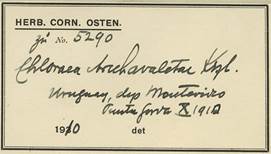
Figure 114 C. Osten's herbarium label of Chloraea arechavaletae Kraenzl. Harvard University Herbaria.
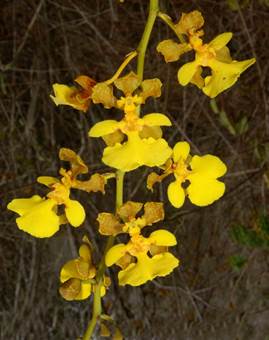
Photo by Lidyanne Aona
Figure 115 Oncidium ostenianum Schltr. =Trichocentrum cepula (Hoffms.) J.M.H.Shaw.
Drawing by R. Singer.
The plant genus Ostenia (Alismataceae) was named in honour of Cornelius Osten by Franz Georg Philipp Buchenau.
Herter, Wilhelm Gustav Franz (1884 - 1958) (collected 1907 - 1950)
Wilhelm Gustav Franz Herter (1884-1958) (Fig. 117) was a German botanist who lived in Uruguay for a large part of his life. Born in Berlin, Herter studied medicine and natural sciences in Freiburg im Breisgau, Berlin, Paris and Montpellier. In Berlin, he received a doctorate, submitting a thesis on the genus Lycopodium in 1908.
In 1907 and between 1909 and 1910, he spent short periods of time in Montevideo, Uruguay, as an assistant in the agronomy faculty at the University of Uruguay; between 1912 and 1913 he was at the Agronomic University of Porto Alegre, Brazil.
Herter worked as head of the grain processing laboratory at the Berlin Agricultural College during WWI, but in 1923 decided to return to Uruguay, where he made important botanical collections and worked with Cornelius Osten on the continuation of Arechavaleta's Flora Uruguaya. In 1925, Herter became a citizen of Uruguay and occupied different positions over the following years at the university and the ministries of education and public health, as well as at the Montevideo Botanical Gardens and Museum. Montevideo became his second home (Fig. 118). In 1927, he began the publication of his series Estudios botánicos en la region uruguaya, part of which was an inventory of the Uruguayan flora with C. Osten (Herter 1927-1957).
Herter not only taught botany but lectured students on Greek antiquity and promoted the study of mycology. He was happily married to Meta Puchert, who sometimes collected plants with him (Fig. 119) and founded the Revista Sudamericana de Botánica, which went through ten volumes.
Only one new orchid species, Phymatidium herteri Schltr. (Fig. 120), was described by Schlechter among the many specimens of Orchidaceae collected by Herter. Helped by the Uruguayan government, Herter travelled to Europe early in 1939 planning to visit the European herbaria to study their Uruguayan specimens. However, the outbreak of World War II (WWII) made it impossible for him to continue his work and to return to Uruguay. He spent the war as director of the Institute of Botany at the Jagiellonian University in Cracow, in occupied Poland. At the end of the conflict, as the German Reich retreated and abandoned Poland, Herter was held directly responsible for the considerable losses suffered in the field of Polish botany, in terms of both men and materials. Indeed, the Polish botanists Wladyslaw Szafer and Bogumit Pawlowski insisted that Herter be brought to account before the Polish courts in 1945, though this never occurred.
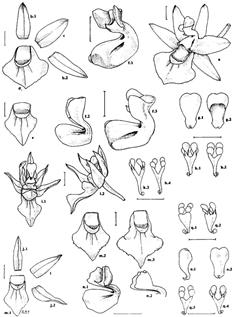
Drawing by A. Toscano de Brito.
Figure 120 Phymatidium herteri Schltr. as Phymatidium micophyllum var. herteri (Schltr.) Toscano.
Immediately after the war, his wife having died in 1946, Herter returned to Uruguay but found himself without an occupation and made his living selling plants. In 1959, he was granted a retirement position by the Uruguayan government and named honorary consul in Bern, Switzerland. In 1954, he finally moved to Hamburg, where he died four years later.












 uBio
uBio 
